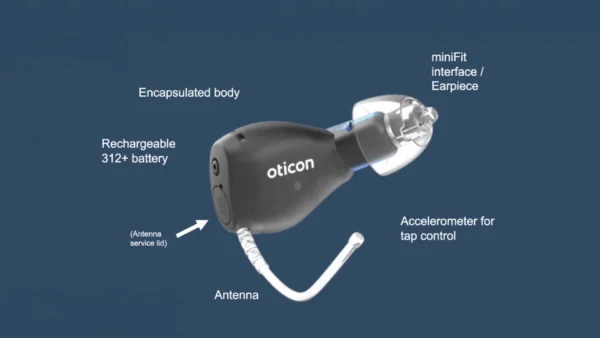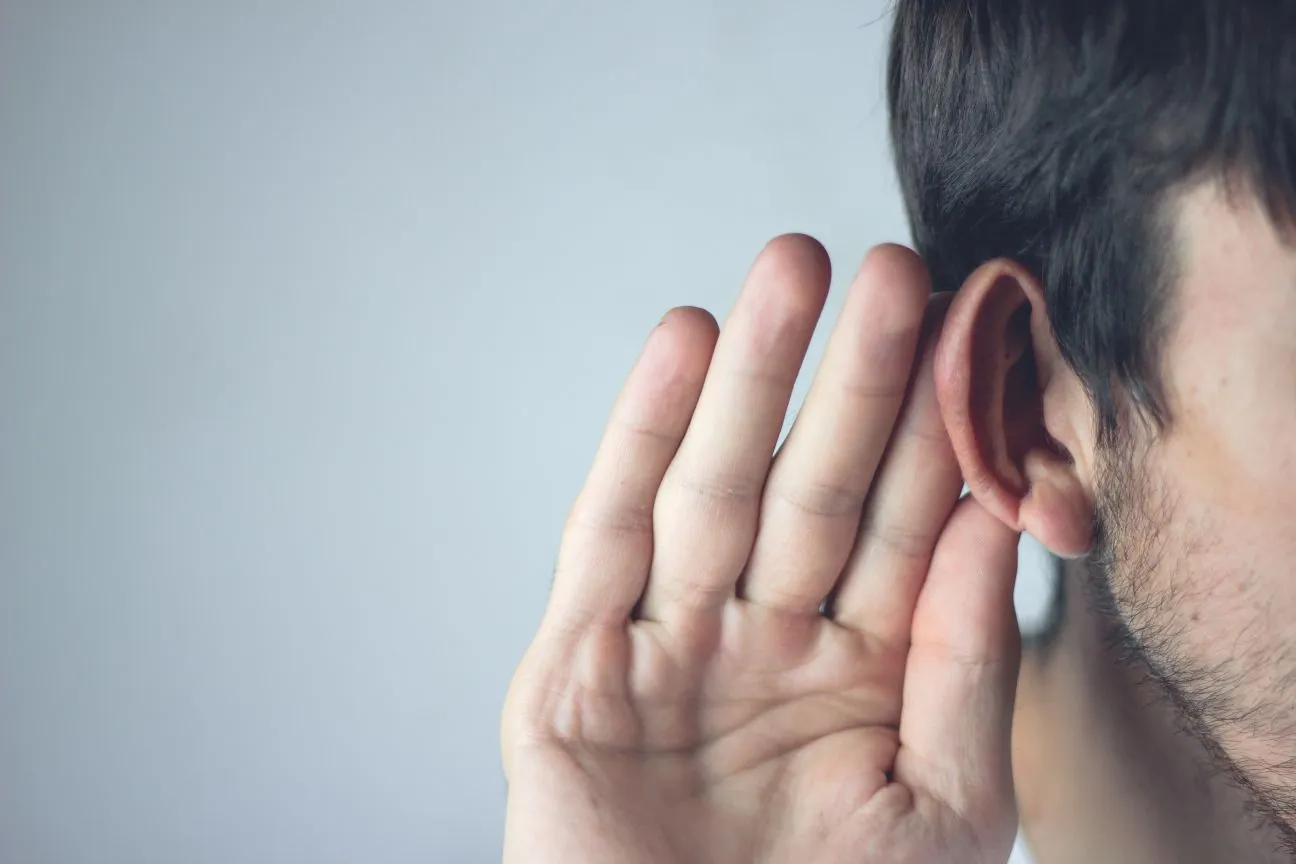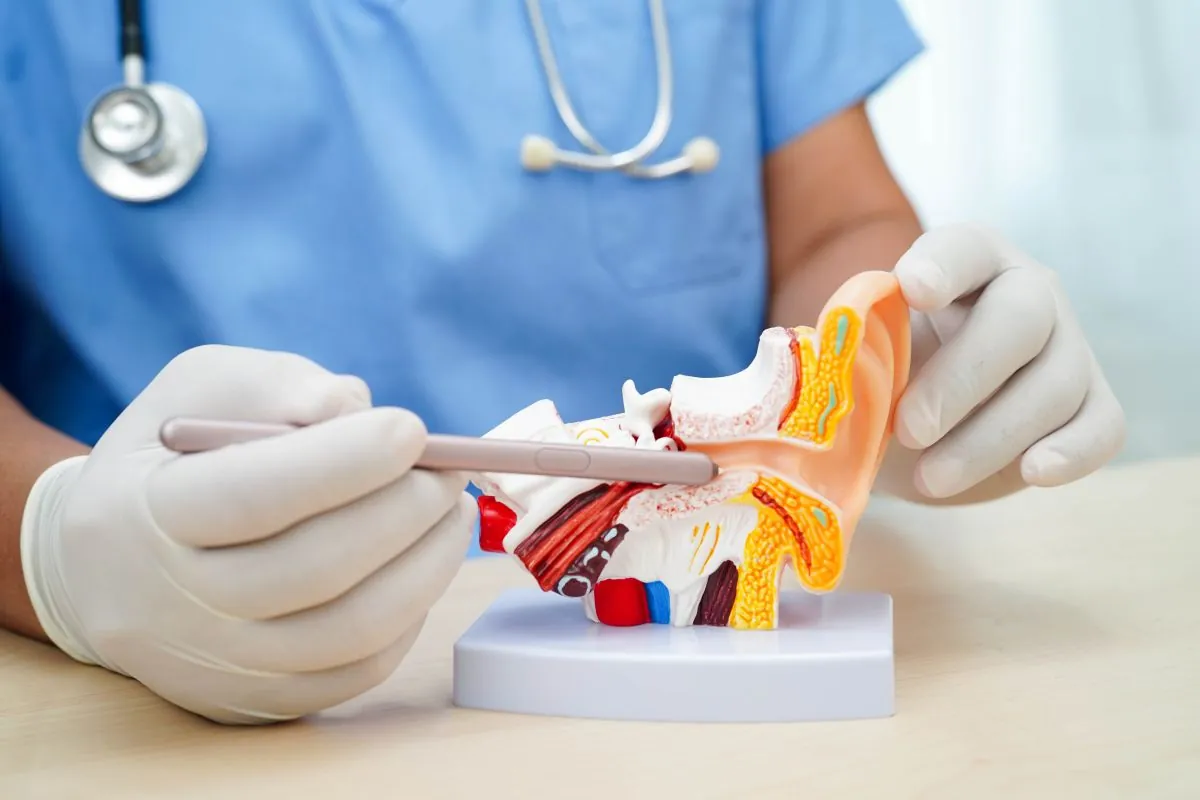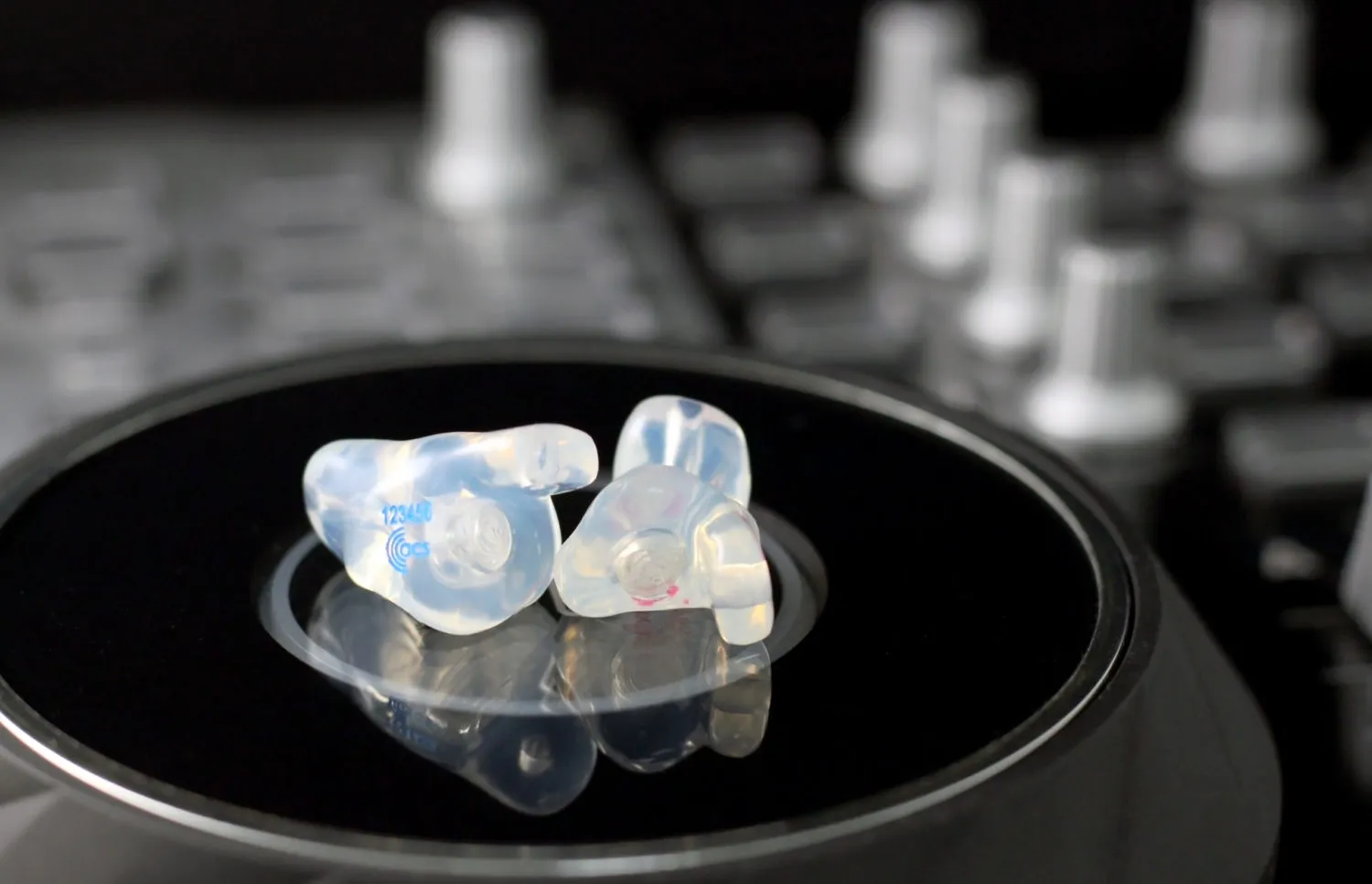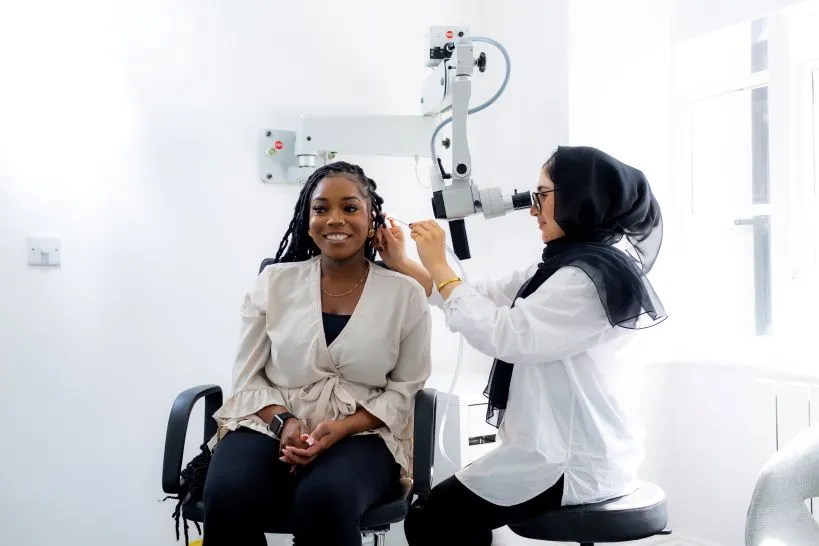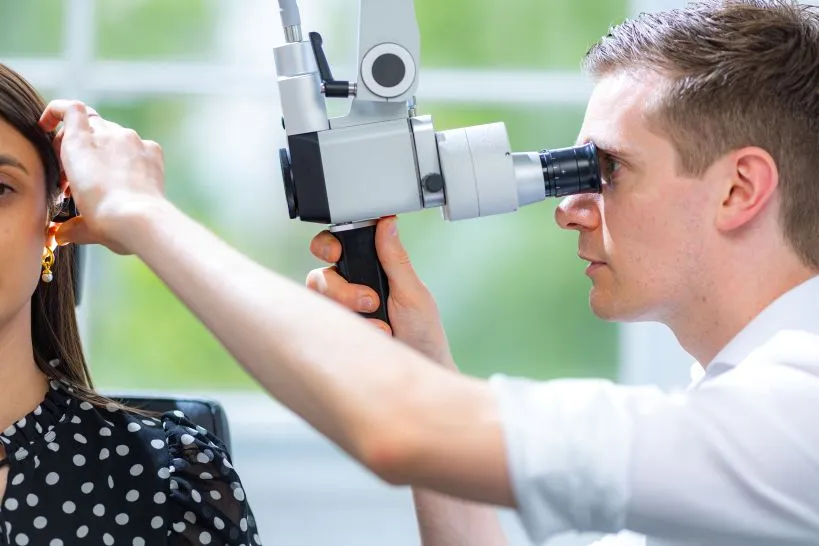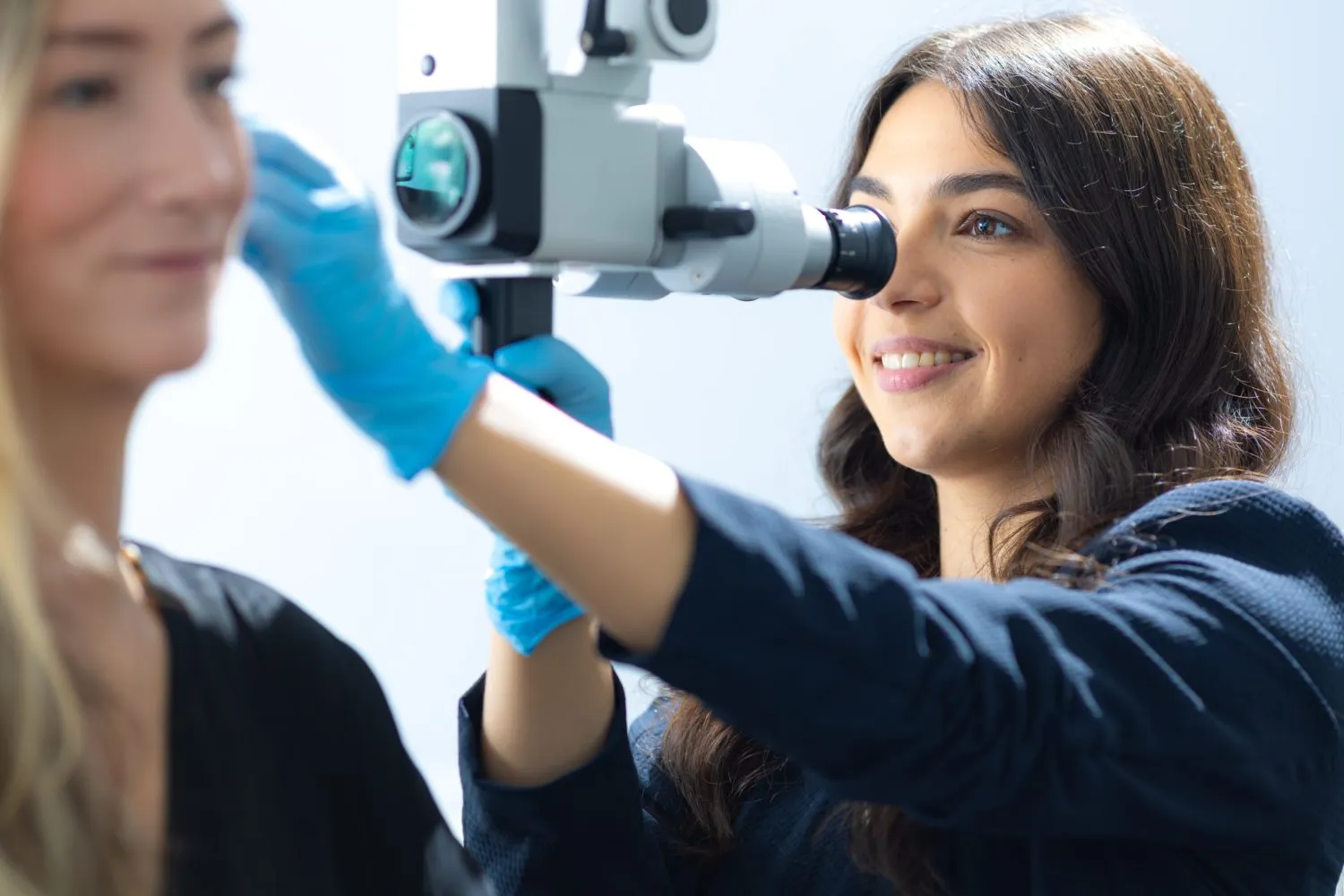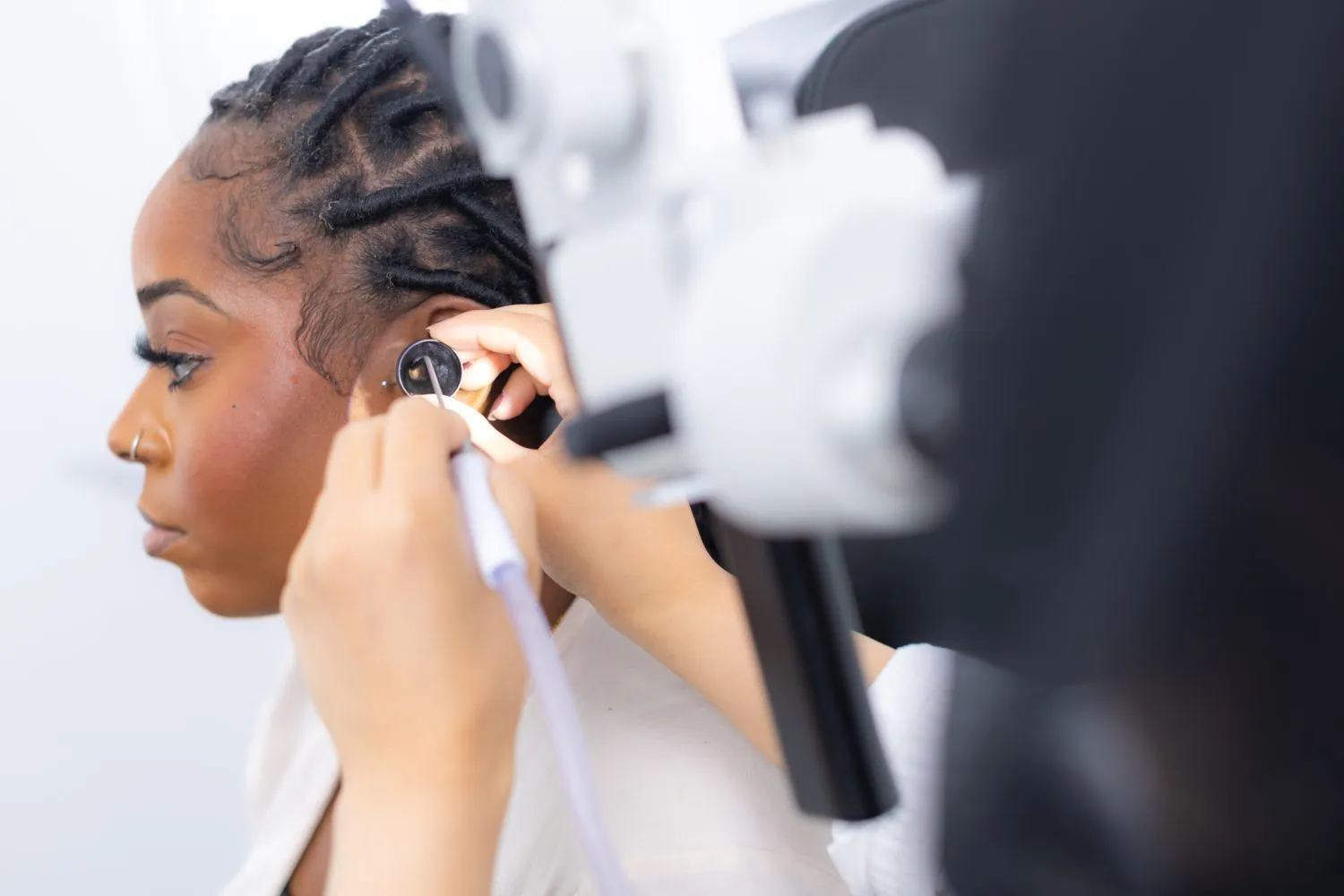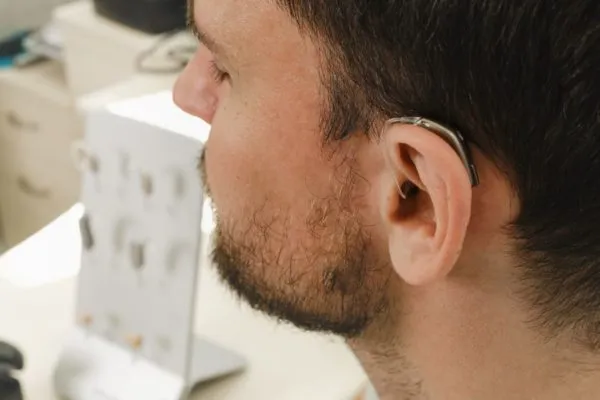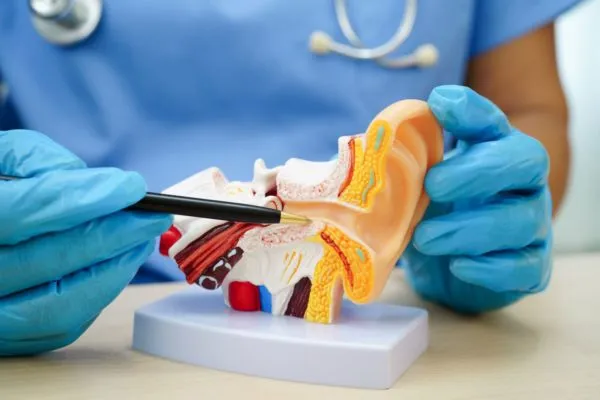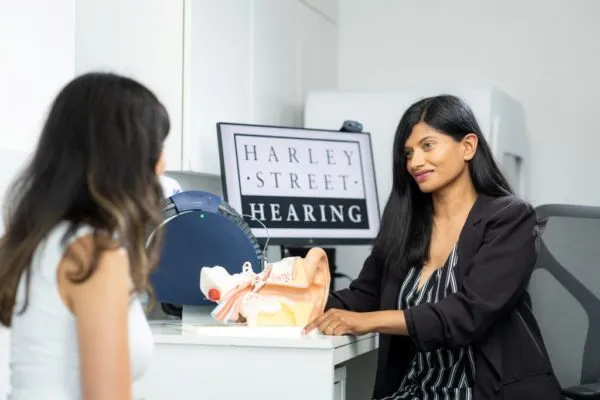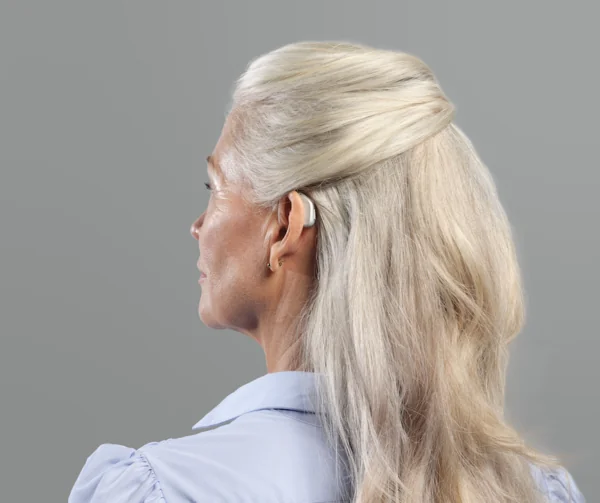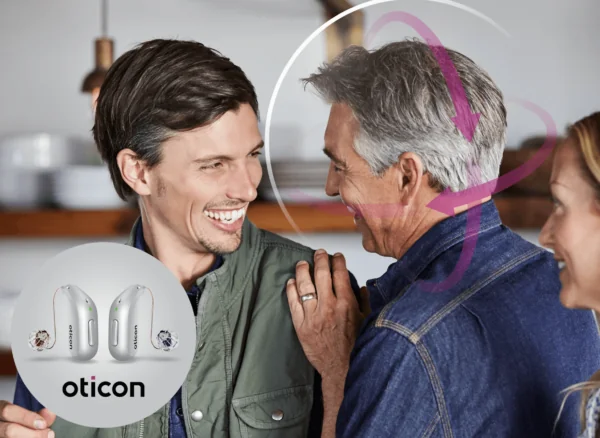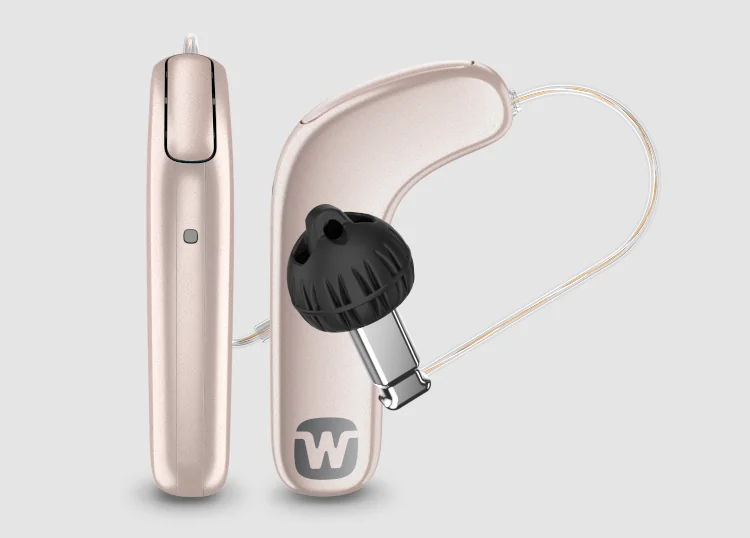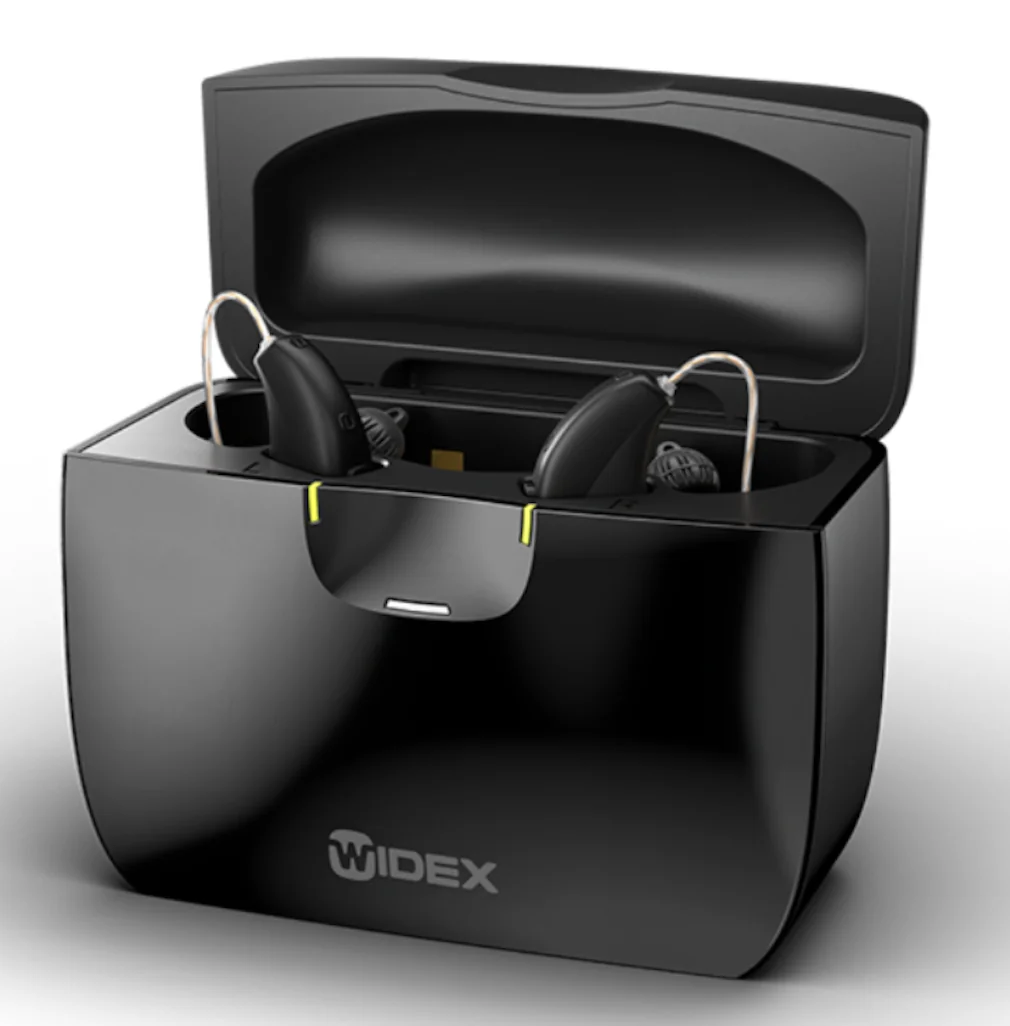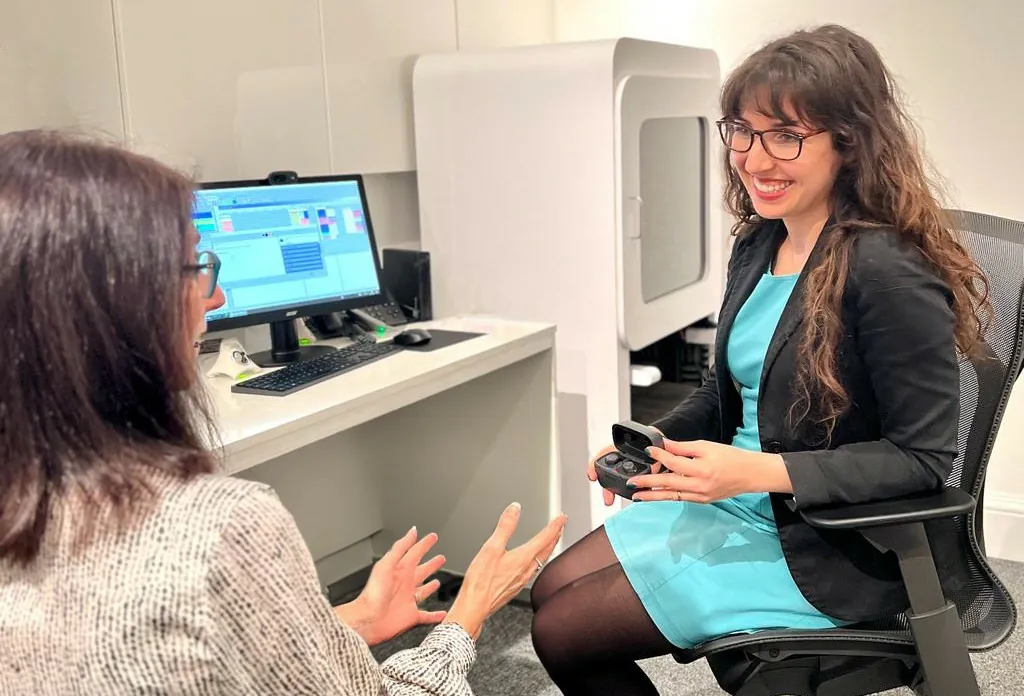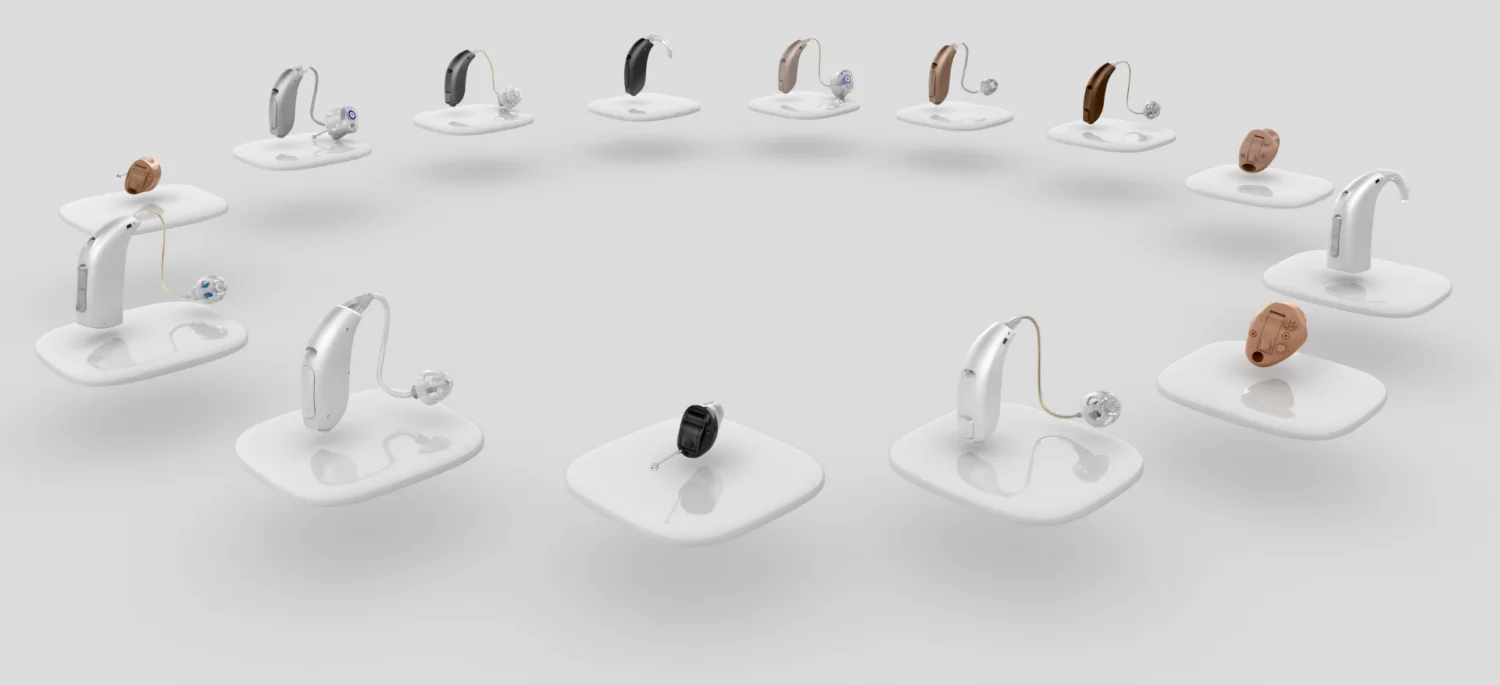
H2 Title
H1 Headline


H2 Title
H1 Headline

Introducing the Oticon Zeal and Phonak Infinio ULTRA Sphere hearing aids
Hearing technology continues to advance at incredible speed, giving users access to smarter, more convenient, and more intuitive solutions than ever before.
At Hampstead Hearing, we are proud to introduce two of the most exciting developments in modern hearing care: the Oticon Zeal and the Phonak Infinio Ultra Sphere.
These two next-generation hearing aids approach innovation from different angles, offering exceptional clarity, connectivity, and comfort for day-to-day listening. Below, we explore what makes each device stand out and which users they are best suited to.
The Oticon Zeal – convenience, connectivity, and discretion redesigned
Oticon’s latest release marks a major step forward for in-the-ear hearing aid technology. The Oticon Zeal bridges the gap between traditional receiver-in-canal devices and fully custom in-the-ear models, combining multiple highly requested features into a single discreet, ready-to-wear hearing aid.
Often described as “the hearing aid many have long asked for”, the Oticon Zeal offers simplicity, performance, and modern design in a compact and user-friendly format.
A modern hearing aid ready straight from the box
The Oticon Zeal is rechargeable, discreet, and designed to be worn immediately without the need for impressions. Key features include:
- Bluetooth connectivity for phone calls and audio streaming.
- Personalised hearing correction tailored through professional programming.
- A compact, in-the-ear design that blends convenience with performance.
While some of these capabilities exist individually in other models, the Zeal is the first in-the-ear device to bring them all together.
A discreet modular design that adapts to you
One of the most impressive features of the Oticon Zeal is its hybrid modular design. Instead of requiring full customisation, the Zeal uses:
- Medical-grade silicone domes for most users.
- Optional custom tips for those who need an enhanced personalised fit.
Only around 30% of users are expected to need custom tips, making the Zeal one of the most accessible in-the-ear hearing aids available.
The device also includes a multi-purpose retention antenna which:
- Enables Bluetooth streaming.
- Acts as a retention arm for added stability.
- Works as an extraction cord.
- Naturally moulds to the shape of the ear over time for improved comfort.
This clever design supports everyday wear while keeping the device discreet and secure.
Rechargeable power for life on the go
The Oticon Zeal provides:
- A full day of listening on a single charge.
- A fast recharge time of just a few hours.
- A charger with a built-in lithium-ion battery for powering up anywhere.
Whether travelling, working long days, or simply avoiding the worry of battery changes, this rechargeable design offers unmatched convenience.
Advanced sound and AI-powered performance
Built on Oticon’s latest platform, the Zeal uses artificial intelligence and motion sensors to enhance speech understanding in challenging listening environments. It automatically adapts to different surroundings by managing background noise in real time.
Through the Oticon Companion app, users can:
- Adjust volume, bass, treble, and programmes.
- Stream calls, music, and media directly to their hearing aids.
- Fine-tune settings quickly from their smartphone.
Who is the Oticon Zeal ideal for?
Hampstead Hearing recommends the Oticon Zeal for:
- Current in-the-ear users who want Bluetooth connectivity and rechargeable performance.
- People who prefer discreet modern designs without sacrificing sound quality.
- Receiver-in-canal wearers who are looking for a bridge between styles.
- New users who like the feel of earbuds but require professional hearing correction.
Suitability is always determined through a complete hearing assessment to ensure a perfect match for your hearing, anatomy, and lifestyle.
Key benefits of the Oticon Zeal
- Discreet in-the-ear design for everyday wear
- Rechargeable with convenient on-the-go charging
- Bluetooth streaming for calls, music, and media
- Modular design with medical-grade domes or custom tips
- AI-driven sound optimisation for clearer speech in different environments
- Easy personalisation via the Oticon Companion app
Phonak Infinio Ultra Sphere – redefining performance and connectivity
Phonak has long been recognised for its industry-leading innovation, and the new Infinio Ultra hearing aid represents a significant step forward in AI-powered sound processing and Bluetooth performance. Following the success of the Infinio Sphere, the Ultra introduces smarter, faster, and more efficient technology.
Advanced AI sound processing
At the heart of the Infinio Ultra is the upgraded DeepSonic processor, trained on nearly 400 million real-world sound samples. This deep neural network allows the hearing aids to separate speech from noise with exceptional accuracy.
With the transition from AutoSense 6.0 to AutoSense 7.0, environmental recognition is now up to 24 percent more accurate. This means:
- Clearer speech in busy settings.
- Smoother transitions between environments.
- Reduced listening fatigue throughout the day.
The Ultra is particularly well-suited to people who rely on excellent performance in challenging surroundings, enjoy music and entertainment, or want a set-and-forget experience that adjusts automatically.
Smarter, more efficient, and longer lasting
Phonak has improved both sound performance and battery life. The redesigned AI system delivers:
- Up to 10.2 dB better signal-to-noise ratio for sharper speech clarity.
- 30% lower power consumption.
- Up to 56 hours of use on a single charge, even with frequent streaming.
This marks a significant leap forward, providing users with increased confidence and reliability throughout the day.
World-class Bluetooth connectivity
Phonak continues to lead in Bluetooth capability. The Infinio Ultra hearing aid features:
- Universal Bluetooth pairing across a wide range of devices.
- Connect up to eight devices simultaneously, with two active at a time.
- A simpler, faster pairing process that improves on previous Phonak systems.
While Auracast is not yet activated, the Ultra still offers some of the strongest Bluetooth performance available.
Phonak has also released the more discreet Infinio Ultra R, which includes the same advanced processing in a smaller design.
Free upgrade for existing Sphere hearing aid users
If you recently purchased the Phonak Infinio Sphere, you can upgrade to the new Ultra features at no additional cost. The process takes one appointment and approximately seven minutes.
Key benefits of the Phonak Infinio Ultra Sphere
- Advanced AI and DeepSonic processor for superior speech clarity
- AutoSense 7.0 for accurate environmental adaptation
- Industry-leading noise reduction for challenging listening situations
- Long battery life (up to 56 hours) and efficient power use
- Universal Bluetooth connectivity with multiple device pairing
- Compact, discreet design (including Ultra R variant)
Choosing the right next-generation AI hearing aid
The Oticon Zeal and the Phonak Infinio Ultra represent two of the most advanced hearing aids available today, each offering unique strengths.
- Choose the Oticon Zeal if you want a discreet in-the-ear design with rechargeable convenience, Bluetooth streaming, and a device that blends the best of in-the-ear and receiver-in-canal styles.
- Choose the Phonak Infinio Ultra Sphere if you want industry-leading noise reduction, world-class Bluetooth connectivity, excellent battery life, and highly accurate automatic sound adjustment.
Book a consultation at Hampstead Hearing
Our expert audiologists are here to guide you through the latest hearing technology. Whether you are interested in exploring Oticon or Phonak solutions, or you would like to upgrade your current hearing aids, we are here to help.
Book your consultation today and discover how next-generation AI hearing aids can enhance your everyday listening experience.
Read More

The importance of regular hearing tests
Have you ever turned up the TV only to realise everyone else thinks it’s too loud? Or found yourself missing parts of a conversation in a busy café? Hearing changes can creep up so gradually that we hardly notice them – yet they can affect how we connect, work, and enjoy everyday life. That’s why keeping track of your hearing health with regular tests is so important.
At Hampstead Hearing, we believe your hearing deserves the same care and attention as your eyesight or dental health. A routine hearing test isn’t just about spotting problems; it’s about maintaining your wellbeing, confidence, and quality of life.
Why regular hearing tests matter
Hearing loss is more common than many people think. Around 18 million adults in the UK experience some degree of hearing loss, and the number continues to rise as we live longer and lead busier, noisier lives. While ageing is a natural factor, other causes such as long-term exposure to loud noise, earwax build-up, certain medications, or even illness can also play a key role.
The tricky thing about hearing loss is how quietly it develops. You might start turning up the volume a little higher or struggle to follow conversations in group settings. But because it happens so gradually, many people adapt without realising just how much they’re missing.
That’s where regular hearing tests make all the difference. By checking your hearing routinely, you can spot early signs of change before they start to affect your daily life.
The impact of untreated hearing loss
Ignoring hearing changes doesn’t just make communication harder. It can have a knock-on effect on many areas of your life.
- Social connection: When you can’t quite follow what’s being said, conversations become frustrating or exhausting. Over time, some people start avoiding social situations altogether.
- Mental wellbeing: Studies have found links between untreated hearing loss and feelings of loneliness, anxiety, and depression.
- Cognitive health: Research also suggests a strong connection between hearing loss and memory decline, including an increased risk of dementia.
- Safety and awareness: Everyday sounds like approaching cars, alarms, or doorbells are essential for keeping safe. Reduced hearing can make these harder to detect.
Regular hearing checks can help you stay alert to changes early, protecting not only your hearing but your confidence, relationships, and overall wellbeing.
What happens during a hearing test?
If you’ve never had a hearing test before, you might be surprised by how simple and comfortable it is. At Hampstead Hearing, we aim to make the process relaxed, informative, and completely tailored to you.
Here’s what usually happens during your appointment:
- A friendly chat: We start with a quick conversation about your lifestyle, medical history, and any hearing issues you’ve noticed. This helps us understand your situation and identify possible causes.
- Ear examination: Using a small light called an otoscope, we’ll check your ears for blockages, wax, or infection.
- Hearing tests: You’ll listen to a series of tones and words played at different volumes and pitches. Don’t worry – there are no right or wrong answers, and it’s all very straightforward.
- Results and advice: Once your test is complete, your audiologist will go through the results in clear, simple language. If we find any hearing loss, we’ll explain your options and recommend next steps.
It usually takes 90 minutes, and many people who come to see us say it’s much easier than they expected.
The benefits of routine hearing tests
Early detection means better outcomes
Hearing loss rarely happens overnight. By the time it becomes noticeable, it may already be affecting your communication and quality of life. Regular hearing tests can catch even the smallest changes, allowing for early intervention and better results.
Protecting your cognitive health
Our brains rely on sound to stay sharp and engaged. When hearing loss goes untreated, the brain works harder to fill in gaps, which can increase fatigue and affect memory. Keeping your hearing in good shape helps support long-term brain health.
Staying connected and confident
Good hearing helps you stay socially active and confident in every environment, whether you’re chatting with family, joining meetings, or dining out. Addressing hearing changes early means you can enjoy those moments without strain or embarrassment.
Preventing further damage
For people exposed to loud environments, like construction sites, music venues, or busy traffic, regular hearing tests can highlight any risks before they lead to permanent damage. Your audiologist can also recommend hearing protection to keep your ears safe.
Personalised support and technology
If hearing aids or assistive devices are needed, modern technology makes them more discreet, comfortable, and effective than ever. Routine testing helps ensure your devices are fine-tuned to match your lifestyle and preferences.
How often should you get a hearing test?
The ideal frequency depends on your age, lifestyle, and hearing history. As a guide:
- Adults under 50 – Every three to five years, unless you notice symptoms sooner.
- Adults over 50 – Every one to two years, as hearing naturally changes with age.
- People exposed to loud noise – Annually, to monitor any impact on hearing health.
If you’ve noticed muffled sounds, ringing in your ears (tinnitus), or often ask people to repeat themselves, don’t wait. Book a hearing test sooner rather than later.
Why should you choose Hampstead Hearing?
At Hampstead Hearing, we provide comprehensive care, taking a holistic approach to your hearing health from your very first test through to ongoing aftercare.
Our expert audiologists bring years of experience in diagnosing and treating all types of hearing loss, using state-of-the-art equipment to ensure accurate results and high-quality hearing aid fittings.
Above all, we pride ourselves on offering a friendly, supportive service, taking the time to listen and explain every step so that you feel comfortable, informed, and reassured throughout your visit.
Take the first step towards better hearing
Hearing loss can sneak up slowly, but taking action doesn’t have to. A simple hearing test could make a huge difference to your everyday life, helping you stay engaged, confident, and connected to the people and sounds that matter most.
If you’ve been thinking about checking your hearing, now is the perfect time. Book your hearing test at Hampstead Hearing today and take the first step towards clearer, more confident hearing.
Read More

Phonak Audeo Sphere Infinio: A Closer Look
Choosing a new hearing aid is a big decision. At Hampstead Hearing, we keep up to date with the latest technology so our patients can make informed choices. One of the most talked-about launches this year is the Phonak Audeo Sphere Infinio.
Phonak has introduced some impressive innovations, especially when it comes to hearing clearly in noisy places. But like any hearing aid, it’s not without its trade-offs. Below, we break down the main features — highlighting both the advantages and the points worth considering.
The Technology at the Heart of Infinio
Clearer Speech in Background Noise
- What’s new: Phonak’s DeepSonic chip, powered by artificial intelligence.
- Why it matters: It separates speech from background noise, trained on more than 22 million sound samples.
- The result: Up to 36.7% better speech understanding in noisy environments.
- What to keep in mind: Advanced processing uses more battery power, which may mean shorter life in busy environments.
Smarter Automatic Adjustments
- What’s new: AutoSense 6.0, an upgrade from Phonak’s previous system.
- Why it matters: It instantly adapts to seven listening situations, so you don’t have to keep adjusting settings yourself.
- The result: Less effort, more natural focus on conversations.
- What to keep in mind: While automatic, it isn’t perfect for everyone — some patients still prefer manual control at times.
Strong Connectivity Features
- What’s new: Classic Bluetooth with universal compatibility.
- Why it matters: You can pair to almost any device — phone, laptop, tablet — and even connect to two at once.
- The result: Hands-free calls, stable streaming, and readiness for future Auracast technology.
- What to keep in mind: Hands-free calling can struggle in very noisy places, meaning callers may not hear you clearly.
A Fit for Different Hearing Loss Levels
- What’s new: Support for ActiveVent receivers, which automatically open or close depending on your environment.
- Why it matters: More natural sound in quiet, more clarity in noise, and richer music during streaming.
- The result: A single hearing aid that adapts across a wide range of listening situations.
- What to keep in mind: The design is slightly larger than some ultra-discreet models, which may be a consideration for patients wanting the smallest option possible.
Durability and Everyday Reliability
- What’s new: A reinforced build across the Sphere range.
- Why it matters: Stronger hearing aids mean fewer breakdowns and more confidence in day-to-day use.
- The result: A practical upgrade for anyone who relies on their devices all day, every day
- What to keep in mind: The Infinio is currently only available in a rechargeable format — there’s no disposable battery option.
What’s Missing From The Phonak Audeo Sphere Infinio?
Despite its cutting-edge features, the Audeo Sphere Infinio does not currently include:
- A telecoil, which is important for patients who regularly use hearing loop systems.
- CROS compatibility, so it isn’t suitable for those with single-sided deafness.
The Bottom Line from Our Audiologists
The Phonak Audeo Sphere Infinio represents a big step forward in hearing technology. Its AI-driven DeepSonic chip, smarter AutoSense 6.0, and market-leading connectivity make it one of the strongest options available today.
However, it’s not perfect for everyone. The rechargeable-only design, slightly larger size, and lack of telecoil or CROS features may steer some patients towards other Phonak models or alternative brands.
At Hampstead Hearing, we take the time to understand your hearing profile, lifestyle, and preferences before recommending a solution. The Infinio could be ideal – but the right hearing aid is always the one that fits you best.
Book a Hearing Aid Consultation
Curious about whether the Phonak Audeo Sphere Infinio could work for you? Book a consultation with Hampstead Hearing today. Our audiology experts will guide you through the latest options and help you find the best fit for your needs.
Read More

The link between hearing loss and cognitive decline
We often think of hearing loss as little more than an inconvenience, a missed punchline in a noisy restaurant or the frustration of constantly turning up the TV. But research is painting a very different picture.
Untreated hearing loss doesn’t just affect our ability to communicate; it has profound consequences for the brain. In fact, growing evidence shows that hearing loss is closely tied to cognitive decline, including dementia. This discovery is transforming how we understand hearing health, shifting it from issues of communication to a cornerstone of protecting brain health as we age.
What the evidence shows
Over the past decade, scientists have uncovered a strong link between hearing loss and cognitive decline. The findings suggest that the worse the hearing loss, the higher the likelihood of developing cognitive issues. One large analysis found that:
- Mild hearing loss nearly doubles dementia risk.
- Moderate loss triples the risk.
- Severe loss is linked with a fivefold increase in risk.
These numbers are not isolated results. Research across countries and populations has consistently found that people with hearing loss are more likely to experience faster cognitive decline. Alzheimer’s Research UK has reported that hearing aid users are about 50% less likely to develop mild cognitive impairment compared to people with untreated hearing loss, and that using hearing aids could reduce the risk of long-term cognitive decline by 19%.
Why hearing loss affects the brain
The connection between hearing and brain health is complex, but researchers have identified several plausible explanations:
Cognitive overload
When hearing is impaired, the brain must work overtime to make sense of sounds. This constant effort diverts resources away from other important processes like memory and problem-solving. Over a long period of time, this extra strain may accelerate cognitive decline.
Social isolation
Communication is central to social life, and hearing difficulties often push people to withdraw from conversations and group activities. Unfortunately, social isolation is a known risk factor for dementia, impacting not only emotional wellbeing but also brain health.
Brain atrophy
The brain thrives on stimulation. When hearing deteriorates, parts of the auditory cortex receive less input. Imaging studies suggest this lack of stimulation may speed up brain shrinkage in regions linked to memory and cognition, reducing overall brain resilience.
The power of early intervention
The encouraging news is that hearing loss is one of the most modifiable dementia risk factors.
Hearing aids and cognitive health
Modern research shows that hearing aids and cochlear implants don’t just improve hearing, they may also protect the brain. For example:
- The ACHIEVE trial, one of the most rigorous studies on the subject, found that older adults with hearing loss who used hearing aids and received audiology support experienced 48% slower cognitive decline over three years compared to those who didn’t.
- Other reviews show that hearing aid users perform better on cognitive tests and experience slower rates of decline than those who let their hearing loss go untreated.
Why timing matters
When it comes to hearing health, timing is critical. A study published in JAMA Neurology revealed that people in their 60s who started using hearing aids had a 61% lower risk of developing dementia. Interestingly, this benefit wasn’t observed in those who began wearing hearing aids later in life, after age 70. This suggests that earlier intervention may help preserve brain function before irreversible changes take hold.
Despite these benefits, hearing aid use remains surprisingly low. Only around 17% of older adults with moderate to severe hearing loss use them. Barriers include stigma, cost, and outdated misconceptions that hearing aids are bulky or ineffective. However, today’s devices are small, discreet, and technologically advanced, many can connect to smartphones and adjust automatically to different sound environments.
Hearing health is brain health
The message is simple, looking after your hearing is one of the best things you can do for your brain. Yet many people wait far too long before seeking help. On average, people delay getting hearing aids for 7 to 10 years after first noticing symptoms. During that window, the risk of cognitive decline only increases.
Practical steps you can take
If you or a loved one has noticed changes in hearing, there are steps you can take to protect both hearing and brain health:
- Get regular hearing checks. Start by midlife, around age 55, or sooner if you notice signs of difficulty. Routine hearing checks should be as normal as eye exams.
- Don’t delay treatment. The earlier you address hearing loss, the greater the chance of protecting long-term brain health.
- Use hearing aids with professional support. Research shows outcomes are better when devices are fitted and fine-tuned by an audiologist.
- Stay socially active. Even with hearing difficulties, staying connected is vital, with hearing aids making social life easier and more enjoyable.
- Challenge the stigma. Hearing aids are tools for living well, just like glasses. They’re not a sign of aging or weakness but of taking charge of your health.
A public health opportunity
On an individual level, treating hearing loss can improve quality of life, communication, and independence. On a societal level, it could have far-reaching effects. Dementia is one of the greatest health challenges of our time, and addressing hearing loss could help prevent or delay thousands of cases.
Book your hearing appointment today
Don’t put your hearing health on hold. If you’ve noticed changes in your hearing, or in the hearing of someone you care about, schedule an appointment with Hampstead Hearing. Our friendly, experienced team is here to answer your questions and provide the expert support you need, every step of the way.
Hampstead Hearing, part of the renowned Harley Street Hearing group, is a leading provider of independent, expert hearing and ear healthcare in the UK. We specialise in comprehensive hearing assessments, state-of-the-art hearing aids, tinnitus management, and a wide range of personalised services designed to support your hearing health.
Read More

Protecting your hearing in noisy environments
In our modern world, exposure to loud noise is almost impossible to avoid. From bustling city traffic and loud music venues to industrial workplaces and even DIY projects at home, the risk of noise-induced hearing loss is ever-present.
Unfortunately, once hearing is damaged, it cannot be restored naturally. This makes it crucial to take proactive steps to safeguard your hearing health – especially when you’re in noisy environments.
Whether you are frequently exposed to loud noise through work, hobbies or lifestyle choices, investing in high-quality hearing protection – and ideally, custom hearing protection – can make all the difference.
At Hampstead Hearing, we are committed to helping you preserve your hearing through education, expert advice and advanced protection solutions tailored to your lifestyle.
Understanding noise-induced hearing loss
Noise-induced hearing loss (NIHL) occurs when the delicate hair cells within the inner ear are damaged by prolonged or sudden exposure to loud noise. These hair cells are responsible for transmitting sound signals to the brain. Once they are destroyed, they do not regenerate, resulting in permanent hearing loss.
Sounds are measured in decibels (dB), and any sound above 85 dB can potentially damage your hearing. For reference:
- Normal conversation: around 60 dB
- Busy traffic: 85-90 dB
- Rock concert or nightclub: 100-110 dB
- Power tools: 90-110 dB
- Fireworks or gunshots: 140+ dB
The louder the noise, the less time it takes for hearing damage to occur. For instance, at 100 dB, it only takes about 15 minutes of exposure to risk permanent damage.
Who is most at risk of noise-induced hearing loss?
While anyone can suffer from hearing damage, some individuals are at higher risk due to their daily activities or professions. This includes:
- Construction and factory workers
- Musicians and DJs
- Commuters and cyclists in busy urban areas
- Sports enthusiasts and spectators
- DIY hobbyists using power tools
- Concert-goers and festival lovers
If any of these describe you or your lifestyle, it is vital to make hearing protection a non-negotiable part of your routine.
Everyday tips for protecting your hearing
Protecting your hearing doesn’t mean you have to avoid the things you love or quit your job. With the right precautions, you can continue your lifestyle safely and comfortably.
Know your noise exposure
Start by understanding the noise levels in your environment. Smartphone apps like Decibel X or SoundPrint can measure noise in real time. If you notice levels frequently exceeding 85 dB, it’s time to take action.
Take listening breaks
If you are exposed to loud noise for extended periods—whether at work, a concert, or even listening to music with headphones—give your ears regular breaks. Quiet moments allow your ears to recover and reduce the risk of cumulative damage.
Turn down the volume
Listening to music or podcasts through headphones or earbuds? Stick to the 60/60 rule: keep the volume below 60% and limit listening to under 60 minutes at a time. Noise-cancelling headphones can also help by reducing the need to turn up the volume in noisy surroundings.
Be smart about event attendance
Loud events like concerts, clubs and festivals can cause temporary hearing loss or tinnitus (ringing in the ears). To minimise risk:
- Stand away from speakers
- Take regular breaks in quieter areas
- Wear ear protection (ideally, custom hearing protection)
Use earplugs or earmuffs
Standard foam earplugs or earmuffs can offer basic protection, reducing noise levels by 15 to 30 dB. However, they are not always comfortable or effective in every situation. This is where our custom hearing protection shine.
Why custom hearing protection is a game-changer
Unlike generic earplugs, custom hearing protection is designed to fit your ears perfectly, offering superior comfort, better noise reduction and more reliable long-term use. At Hampstead Hearing, we offer bespoke solutions tailored to your lifestyle, whether you’re a musician, motorcyclist, tradesperson or festivalgoer.
Benefits of custom hearing protection:
Custom earplugs offer a range of advantages over off-the-shelf alternatives, starting with their personalised fit. Because they are moulded to the exact shape of your ear canal, they stay securely in place without slipping or causing discomfort. This snug fit also helps to minimise irritation, even during prolonged use, while providing a comfortable and effective seal that blocks out harmful noise more reliably than generic options.
Another key benefit is that custom earplugs reduce noise levels without muffling important sounds. Unlike foam plugs, which often dull everything indiscriminately, custom filters are designed to preserve clarity. This means you can still hear speech and ambient sounds clearly while protecting your ears from damaging noise levels – an essential feature for musicians, teachers, sound technicians, and anyone working in high-volume environments.
Custom earplugs are also a smart long-term investment. Though they cost more upfront than disposable plugs, they are reusable and built to last, making them highly cost-effective over time. With proper care, many of our clients use theirs for years.
Perhaps the biggest strength of custom hearing protection is its versatility. At Hampstead Hearing, we create tailored solutions for a wide range of lifestyles. Musicians benefit from filters that preserve sound quality while reducing volume.
Motorcyclists can enjoy reduced wind and road noise without compromising awareness of traffic. Industrial workers are protected with high-attenuation filters that meet safety standards, while sleepers can find relief with soft, comfortable plugs that minimise nighttime disturbances. We also provide waterproof options for swimmers, helping to prevent ear infections and keep ears dry.
Summarise the benefits of custom hearing protection:
- Personalised fit – Custom earplugs are moulded to your ear shape, ensuring they stay in place and remain comfortable, even during long periods of wear.
- Comfortable and secure – They minimise irritation and provide a reliable seal for better noise isolation.
- Clear sound quality – Unlike foam plugs, custom filters reduce harmful noise while still allowing you to hear speech and ambient sounds clearly.
- Cost-effective over time – Though more expensive initially, custom earplugs are reusable and durable, making them a long-term investment.
- Versatile for different needs – Options available for musicians, motorcyclists, industrial workers, sleepers, and swimmers, each tailored to specific lifestyles and environments.
The hidden risks of ignoring hearing protection
Too often, people wait until they notice symptoms of noise-induced hearing loss before taking action. Common early signs of hearing damage include:
- Ringing or buzzing in the ears (tinnitus)
- Muffled hearing after exposure to noise
- Difficulty understanding conversations in noisy places
- Turning up the volume more often than usual
Once these signs appear, the damage may already be permanent. Early intervention is crucial.
Ignoring these signs can result in long-term consequences, including social isolation, communication difficulties, and even cognitive decline. Studies show a strong link between untreated hearing loss and increased risk of dementia in later life. Protecting your hearing today means protecting your quality of life tomorrow.
Why choose Hampstead Hearing?
At Hampstead Hearing, we specialise in hearing health solutions that prioritise comfort, precision, and long-term wellness. Our audiologists have years of experience providing:
- Comprehensive hearing assessments
- Expert advice on hearing protection
- Custom-fitted earplugs for every lifestyle
- Ongoing care and aftercare support
We take the time to understand your unique needs and work with you to design a solution that fits your lifestyle and keeps your hearing safe in any environment. Whether you’re looking to protect your hearing at work, while enjoying your favourite hobbies, or simply want peace of mind during everyday activities, we’re here to help.
Book your hearing appointment today
Don’t wait until it’s too late. If you regularly find yourself in noisy environments – whether for work, leisure or travel – it’s time to act. Custom hearing protection is an investment in your long-term wellbeing, and we’re here to guide you every step of the way. Book your hearing protection consultation with Hampstead Hearing today and let our specialists help you find the perfect solution to suit your needs.
Hampstead Hearing, part of the renowned Harley Street Hearing group, is a leading provider of independent, expert hearing and ear healthcare in the UK. We specialise in comprehensive hearing assessments, state-of-the-art hearing aids, tinnitus management, and a wide range of personalised services designed to support your hearing health.
Read More
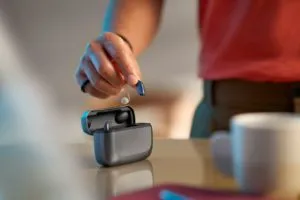
Introducing the Resound Vivia hearing aid
The new ReSound Vivia hearing aids, launched in early 2025, bring together cutting-edge technology and everyday practicality. Designed to help people hear more clearly in all kinds of environments, Vivia combines smart features, Bluetooth and Auracast connectivity, alongside user-friendly controls – all in a sleek, discreet design.
In this post, we’ll walk you through the key features of ReSound Vivia, who it’s best suited for, and what to keep in mind when considering it as your next hearing solution.
A quick look at the ReSound Vivia hearing aids
ReSound Vivia is available in four different models, each designed with different needs in mind:
- Micro RIC R (V160) – a small rechargeable hearing aid packed with AI features
- RIC 312 (V161) – uses disposable size 312 batteries
- RIC 13 (V162) – uses disposable size 13 batteries and includes a telecoil
- CROS R – rechargeable, designed for people with single-sided deafness
The Micro RIC R is the smallest of the range and carries the most advanced technology, including built-in artificial intelligence. It’s ideal for those who want a discreet look without compromising on performance.
The RIC 312 and RIC 13 models offer more traditional battery options. The RIC 13 is particularly useful for those who need a telecoil to connect to hearing loop systems, such as in theatres, churches or public buildings.
For users with hearing loss in only one ear, the rechargeable CROS R works alongside a compatible hearing aid to wirelessly transmit sound from the non-hearing side to the hearing side. It’s important to note that the AI features in the Micro RIC model are turned off when used with a CROS setup, to help conserve battery life.
AI hearing aids that work with you
One of the most exciting features of ReSound Vivia is its built-in artificial intelligence, designed to help users hear better in noisy environments. This feature, known as Intelligent Focus, is available in the Micro RIC R when fitted at the premium technology level.
The AI has been trained using millions of real-world sound environments. When switched on, it focuses on speech and reduces background noise, making it easier to follow conversations in busy places like cafés, restaurants or social gatherings.
Whilst constantly adjusting in the background to assist with your hearing, the Resound Smart 3D App also gives you control of additional AI features, such as ‘speech clarity’ emphasis and additional ‘noise reduction’, giving the user greater control over their listening experience.
You can activate it manually, either with a simple button press on the hearing aid or via the ReSound Smart 3D app. This gives you full control over when you want extra support – without surprises or sudden changes in sound.
Battery life that keeps up with you
The Micro RIC R model provides a strong rechargeable battery that lasts up to 30 hours on a single charge. If you’re using the AI features or doing a lot of Bluetooth streaming, battery life will be closer to 20 hours – still enough for a full day’s use.
Forgot to charge overnight? A quick 10-minute top-up gives you nearly 3 hours of extra listening time – perfect for last-minute dashes out the door.
If you’d rather stick with traditional batteries, the RIC 312 and RIC 13 offer excellent flexibility without compromising on sound quality. As mentioned earlier, the RIC 13 is your go-to if you need access to loop systems, thanks to its built-in telecoil.
Next-generation connectivity with Auracast
ReSound Vivia is fully equipped with Bluetooth Low Energy Audio, including support for Auracast – a new kind of audio broadcasting designed for public places. Auracast lets users tune into announcements or audio streams in venues like airports, theatres and conference centres, directly through their hearing aids and is expected to overtake traditional loop systems as the go-to hearing support system in public spaces over the coming years.
The Smart 3D app includes an Auracast Assistant, which helps users connect to these broadcasts easily when they’re available. While this technology is still rolling out in the UK, having a Vivia hearing aid means you’ll be ready when it becomes more common.
If you currently rely on hearing loops, you may still prefer the RIC 13 model until Auracast becomes widely available.
Built to last, designed to fit
Every hearing aid model in the Vivia range has been thoughtfully designed for everyday life. One useful update is the new microphone cover, which helps protect the microphones from dust and debris. These covers only need to be changed once a year and can be replaced either in clinic or at home.
The hearing aids are water and dust resistant, with a protective coating to help them stand up to daily wear. They also come in nine different colours, so whether you want something subtle or a bit more stylish, there’s something to suit your taste.
The ReSound Smart 3D app: Full control at your fingertips
The Smart 3D app gives you easy control over your hearing aids straight from your phone. You can adjust volume, change sound settings, switch between programmes, and even activate Intelligent Focus – all with a few taps.
It also includes location-based memory, meaning your hearing aids can remember your preferred settings for specific places. For example, if you’ve customised your settings at your favourite café, the aids can automatically adjust next time you go.
For added convenience, the Micro RIC model includes tap control. This means you can answer phone calls or activate your phone’s voice assistant with a gentle tap on the hearing aid – no phone handling required.
What do experts say about ReSound Vivia?
Early feedback from audiologists and users has been very encouraging. Many describe the sound as natural and clear, especially in quiet settings or when streaming music. In busy environments, users notice a real difference when Intelligent Focus is switched on, helping them follow conversations more easily.
Clinically, Vivia highlights the importance of precise fitting. Real-ear measurements (REM) are essential to make sure the AI works as intended and gives users the best possible results.
Who is ReSound Vivia best for?
ReSound Vivia is an excellent choice for adults with mild to severe hearing loss who want a modern, reliable, and discreet hearing aid. It’s especially well-suited to people who lead busy lives, spend time in a mix of quiet and noisy places, and want the flexibility to take control of their listening experience.
If you rely on hearing loops, the RIC 13 model will meet your needs. If you have hearing in only one ear, the CROS R system offers a seamless solution.
For commuters, professionals, and those with active social lives, Vivia offers a powerful blend of performance, battery life and future-ready features – making everyday hearing that little bit easier.
Interested in trying a ReSound Vivia hearing aid?
At Hampstead Hearing, we’re proud to offer the full ReSound Vivia range. Our expert audiologists provide detailed hearing assessments, real-ear measurements and tailored fittings to help you get the very best from your hearing aids.
To find out whether ReSound Vivia is right for you, get in touch today to book a consultation.
Read More

Earwax removal: What you need to know
Earwax plays a vital role in protecting your ears from dust, bacteria, and foreign particles. While it might not be the most glamorous topic, ear health is essential – and that includes understanding when and how to remove earwax safely.
Hampstead Hearing specialise in safe, effective microsuction earwax removal, providing expert care for those suffering from blocked ears or hearing difficulties due to wax build-up.
In this blog, we’ll explore the importance of professional earwax removal, the potential dangers of DIY methods, and how our team can help restore your hearing and comfort with safe, clinically approved techniques.
Why is earwax important?
Before diving into removal methods, it’s worth knowing why earwax exists in the first place. Earwax is produced by glands in the ear canal and serves several protective functions:
- Traps dust and debris: Preventing foreign particles from reaching the eardrum.
- Has antibacterial properties: Helping to prevent infections.
- Keeps the ear canal lubricated: Reducing itchiness and dryness.
In most cases, earwax naturally migrates out of the ear canal on its own. However, for some people, earwax can build up and become impacted, leading to discomfort, muffled hearing, and in some cases, ear infection.
Signs of earwax build-up
While not everyone experiences symptoms, there are several common signs that may indicate you need earwax removal.
You might notice a sudden or gradual loss of hearing, which can be caused by wax blocking the ear canal. A feeling of fullness or blockage in the ear is another tell-tale sign, often described as a sensation of having ‘something stuck’ inside the ear.
Ringing in the ears, known as tinnitus, can also be triggered by a build-up of wax. Some people experience earache or general discomfort, which may be mild or more persistent. In more severe cases, excessive wax can affect your balance, leading to dizziness or a sense of unsteadiness.
You may also hear a crackling or popping noise in the ear, particularly when chewing or moving your jaw, which can be a result of shifting wax. Some people find that wax build-up becomes worse after swimming or showering, as moisture can cause the wax to expand, intensifying the blockage. These symptoms can interfere with everyday activities like talking on the phone, enjoying music, or socialising in noisy environments.
If you’re experiencing any of these symptoms, it’s best to consult a hearing professional rather than reaching for the cotton buds!
The dangers of DIY earwax removal
Searches for how to remove earwax often bring up a plethora of home remedies – from ear candling to using cotton buds or at-home irrigation kits. However, these methods are not only ineffective, but can also be dangerous!
Here’s why DIY earwax removal is not recommended and should be avoided at all costs:
- Risk of injury: Using cotton buds or hairpins to ‘dig out’ wax can cause trauma to the delicate ear canal or even puncture the eardrum.
- Pushing wax further in: Instead of removing wax, you’re likely to push it deeper into the ear canal, causing further impaction and potentially worsening the blockage.
- Infection risk: Home remedies that involve inserting foreign objects or liquids into the ear can introduce bacteria and lead to ear infections.
- Ear candling is a myth: Despite persistent online claims, ear candling has been widely debunked by medical professionals. It poses a serious burn risk and does not effectively remove wax.
In short, DIY ear cleaning is not worth the risk. Professional assessment and treatment will ensure your ears remain healthy and clear.
The benefits of professional earwax removal
Microsuction earwax removal is widely considered the safest and most effective method for removing excess wax. It involves using a gentle medical suction device to remove wax under direct visualisation with a specialised microscope.
Unlike syringing or irrigation, it does not introduce moisture into the ear, making it a cleaner and more precise method.
The benefits of microsuction include:
- Safe: Performed under magnification by a trained audiologist.
- Quick: Typically takes just 20-30 minutes.
- No mess: No water is involved.
- Immediate relief: Most patients report an immediate improvement in hearing and comfort.
Our earwax removal service is tailored to your needs and comfort, ensuring you’re receiving the best hearing care in Hampstead.
What to expect during your appointment
We start with a consultation and visual assessment, during which we examine your ear canal using an otoscope or video otoscopy. We will also discuss your symptoms and medical history. This ensures we understand your needs and can tailor the procedure accordingly.
Next comes the wax removal via microsuction. Using a precision suction device, we gently extract the wax while monitoring the process through a high-resolution microscope. This ensures accuracy, safety and comfort throughout the procedure.
Finally, we provide aftercare and advice to help you maintain healthy ears and reduce the likelihood of future wax build-up. This may include tips on ear hygiene and guidance on how often you might need check-ups.
Many patients find the process to be comfortable, and even relaxing, with minimal to no discomfort. Most notice an immediate improvement in hearing and overall ear comfort.
Our commitment to safe and expert care
If you’ve been searching online for how to remove earwax, let us save you the guesswork. We understand how frustrating blocked ears can be. That’s why our audiologists are specially trained in earwax removal and equipped with the latest technology to ensure a comfortable, stress-free experience.
We follow strict hygiene protocols and offer same-day appointments where possible, so you don’t have to wait to hear clearly.
Think you’re experiencing signs of earwax build-up? Book your earwax removal appointment today or call 020 3657 8121 to speak to one of our helpful receptionists. Whether you’re experiencing symptoms or simply want peace of mind, our friendly team is here to help.
Hampstead Hearing, part of the renowned Harley Street Hearing group, is a leading provider of independent, expert hearing and ear healthcare in the UK. We specialise in comprehensive hearing assessments, state-of-the-art hearing aids, tinnitus management, and a wide range of personalised services designed to support your hearing health.
Read More

Does my child need a hearing test? Recognising the signs early
As a parent or carer, you instinctively know when something isn’t quite right with your child. Perhaps it’s the way they don’t respond when you call their name, or how they’ve started saying “what?” more often. Maybe their speech development seems delayed compared to their peers, or a teacher has mentioned difficulty with listening in class.
These moments can stir concern – and rightly so. Hearing plays a fundamental role in your child’s development, influencing how they speak, learn, and connect with others. That’s why identifying potential hearing issues early on is so important.
At Hampstead Hearing, we help you recognise the signs and support you and your child towards better hearing. This blog explores the signs of hearing loss at different stages of childhood, why early intervention matters, and how a professional children’s hearing assessment can offer answers and peace of mind.
Understanding hearing loss in children
Hearing loss in children may be present from birth (known as congenital hearing loss), or it may develop later due to infections, injury, or other health conditions. Some babies are diagnosed early through routine newborn screening, but not all cases are caught immediately. For others, hearing issues become noticeable as the child grows and begins to communicate more.
Even a mild or temporary loss of hearing, such as that caused by frequent ear infections, can impact how your child interacts with the world. That’s why it’s crucial to recognise the signs and take action promptly.
Key signs by age group
Babies and toddlers (0 – 2 Years)
In the earliest months of life, babies should begin reacting to sounds around them. Some of the signs that may suggest a hearing problem include:
- No reaction to loud sounds: Babies are typically startled by loud noises. A lack of response could be an early warning sign.
- Delayed babbling or sound-making: By six months, most babies will start to babble and make a variety of sounds. Limited vocalisations may indicate that they’re not hearing well.
- Not responding to their name: By the age of 9 – 12 months, your child should start responding when you say their name. If they don’t, it may be more than just a distraction.
Preschool children (Ages 2 – 5)
As children become more verbal and socially aware, hearing issues can begin to affect their behaviour and language development. Look out for:
- Difficulty following verbal instructions: If your child often has trouble understanding what you’re asking, especially in a quiet setting, it may not be a behavioural issue, but a hearing one.
- Limited vocabulary or unclear speech: If their speech is noticeably behind for their age, hearing loss could be a contributing factor.
- Asking for things to be repeated: Repeatedly saying “what?” or appearing to mishear common words may be a sign that your child isn’t hearing clearly.
School-aged children (5+ Years)
In school, children are expected to follow complex instructions, engage in group discussions, and learn through both listening and doing. Hearing difficulties at this stage can lead to:
- Struggling in class: If your child finds it hard to keep up with the pace of lessons or misinterprets questions, it may stem from hearing problems.
- Social withdrawal or frustration: Children may begin to avoid group play or show frustration when they can’t follow conversations, especially in noisy environments.
- Frequent ear infections: Ongoing or recurring ear infections can result in temporary or even permanent hearing loss if not properly managed.
Why early detection is so important
Untreated hearing loss can lead to delays in speech and language, difficulties in academic achievement, and social isolation. Early detection allows for early support, helping your child build the skills and confidence they need to thrive.
The good news is that hearing tests for children are straightforward, non-invasive, and often even fun, especially when handled by specialists used to working with younger patients.
At Hampstead Hearing, we offer a warm, welcoming environment where your child’s comfort comes first. Our audiologists are highly trained in working with children, ensuring accurate results and a positive experience.
What happens during a children’s hearing assessment?
We provide comprehensive assessments tailored to your child’s age and developmental stage. A typical test may include:
- Otoscopy: A visual check of the ear canal and eardrum to rule out any blockages or infection.
- Tympanometry: Measures how well the eardrum responds to changes in air pressure – useful in detecting conditions like glue ear.
- Otoacoustic Emissions (OAE): A quick, gentle test that checks how well the inner ear is working.
- Play Audiometry: For younger children, we make hearing tests fun by incorporating games and playful activities that help assess their hearing levels.
- Pure Tone Audiometry: A more traditional test using headphones to detect hearing thresholds, usually suitable for older children.
Following the assessment, you’ll receive a clear, jargon-free report and, if necessary, recommendations for next steps or onward referrals.
Treatment and support options
If a hearing loss is identified, please try not to worry! There are many excellent support options available to help your child.
Hearing aids for children
Modern hearing aids are compact, powerful, and even customisable. Many children enjoy choosing colourful cases or fun accessories, which can help reduce any stigma or discomfort. These devices can be adjusted as your child grows and their hearing needs change.
Speech and language therapy
If hearing issues have impacted your child’s language development, therapy can play a crucial role in catching them up. We work closely with local therapists and can support onward referrals.
Ongoing monitoring
Children’s hearing can change over time. That’s why regular follow-ups are important, whether your child has a diagnosed hearing loss or has experienced recurring ear problems.
Encouraging your child to embrace hearing aids
Getting used to hearing aids can take time, especially for younger children. As a parent or carer, your support makes all the difference. Here are some tips:
- Make it part of their routine: Like brushing teeth or putting on shoes.
- Let them personalise the device: With stickers, colours, or themed cases.
- Celebrate small wins: Praise and positive reinforcement help build confidence.
- Show role models: Books, TV shows, or public figures who wear hearing aids can help normalise their use.
Book your child’s hearing test at Hampstead Hearing
If you’ve noticed any signs of hearing difficulties in your child, don’t wait. A simple hearing test can provide clarity and, if needed, get you started on the right path to support.
We offer professional, friendly care for families throughout North London. We’re committed to helping every child reach their full potential by ensuring their hearing health is taken seriously. Book an appointment online today or call 020 3657 8121 to get in touch.
Hampstead Hearing, part of the renowned Harley Street Hearing group, is a leading provider of independent, expert hearing and ear healthcare in the UK. We specialise in comprehensive hearing assessments, state-of-the-art hearing aids, tinnitus management, and a wide range of personalised services designed to support your hearing health.
Read More
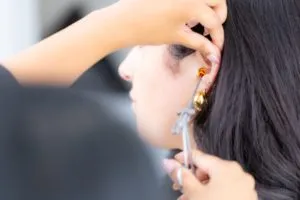
How to choose the right hearing aid for you
Choosing the right hearing aid is a pivotal decision that can significantly enhance your quality of life. With a myriad of options available, it’s essential to understand the different types of hearing aids, the leading brands behind the aids, and how to select a device that aligns with your budget, lifestyle and individual needs.
Hampstead Hearing are dedicated to providing expert audiological care designed to meet your needs. Our skilled team of audiologists offers thorough hearing assessments, customised fittings and access to cutting-edge hearing aid technology. In this article, we’ll be sharing our expertise and opinion on the hearing aids available on the market today.
Understanding the types of hearing aids
Hearing aids come in various styles, each designed to cater to specific preferences and degrees of hearing loss:
- Receiver-in-Canal (RIC): Similar to BTE aids but with the receiver placed inside the ear canal, RIC devices offer a more discreet appearance and natural sound quality.
- Invisible-in-Canal (IIC): As a type of invisible hearing aid, IIC devices are placed deep within the ear canal, making them virtually undetectable. They are best suited for individuals with mild to moderate hearing loss.
- In-the-Canal (ITC) and Completely-in-Canal (CIC): These are smaller, custom-fit aids that sit partially or entirely within the ear canal, making them less visible. However, their size may limit functionality and battery life.
- In-the-Ear (ITE): Custom-made to fit the outer ear, ITE aids are more visible but can house additional features due to their size. They are typically used for mild to severe hearing loss.
- Behind-the-Ear (BTE): These devices rest behind the ear, with tubing connecting to an earmould inside the ear canal. Suitable for all ages and most types of hearing loss, BTE aids are known for durability and ease of handling.
Exploring leading hearing aid brands and their philosophies
Several reputable brands offer a range of hearing aids, each with a unique approach to hearing health:
- Phonak: Renowned for innovative technology, Phonak focuses on delivering comprehensive hearing solutions that adapt to various listening environments, ensuring users remain connected to the world around them.
- Oticon: Emphasising “BrainHearing” technology, Oticon designs aids that support the brain’s natural processing, aiming to reduce listening effort and improve speech understanding.
- Starkey: Known for combining great sound quality with health-focused features, Starkey offers hearing aids with innovations like fall detection and voice-activated controls.
- Signia: Combining audiological performance with stylish designs, Signia offers features like Own Voice Processing (OVP) to provide a natural hearing experience.
- ReSound: Pioneering in connectivity, ReSound provides aids with seamless integration to smart devices, allowing for personalised sound settings and direct streaming.
- Widex: Known for natural sound quality, Widex incorporates machine learning in their devices to adapt to user preferences over time.
Best hearing aids for 2025
2025 has introduced a selection of outstanding hearing aids, each offering innovative features to suit a variety of lifestyles and hearing needs:
- Phonak Lyric – The only 100% invisible hearing aid worn deep in the ear canal 24/7 for months at a time. It delivers clear, natural sound and requires no daily handling or battery changes, making it ideal for ultimate discretion and convenience.
- Phonak Infinio Sphere – Phonak’s newest premium offering, the Infinio Sphere, leverages cutting-edge signal processing to deliver crystal-clear, immersive sound in dynamic environments. Designed with a focus on effortless communication and user comfort, it adapts intelligently to complex listening situations, making it a standout option for those seeking both performance and personalisation.
- Oticon Own SI – Combining discreet design with advanced BrainHearing™ technology, Oticon Own SI supports the brain’s natural processing of sound. It offers exceptional speech clarity, all-day comfort with a custom fit, and high durability with an IP68 rating for water and dust resistance.
- Signia Pure Charge&Go BCT IX – This model features universal Bluetooth® Classic connectivity, allowing seamless pairing with most devices. It boasts a 36-hour battery life (including 5 hours of streaming), RealTime Conversation Enhancement for improved speech understanding in noisy environments, and a compact, comfortable design.
- ReSound Nexia – Known for excellent connectivity, it features Bluetooth LE Audio for better streaming, lower power consumption, and more personalisation via the ReSound Smart 3D app.
- Widex Allure – Focused on delivering natural sound through ZeroDelay™ technology and personalisation using artificial intelligence. Ideal for those who value refined sound and subtle design.
- Starkey Genesis AI – Combines strong audiological performance with wellness tracking, fall detection, and voice-activated commands. An excellent choice for users who want hearing support and smart health features.
These models represent the best current hearing aids of 2025, blending discretion, innovation and high-quality sound to meet a wide range of preferences and hearing requirements.
Factors to consider when choosing a hearing aid
Selecting the right hearing aid involves assessing several important factors, including your degree of hearing loss, lifestyle, budget, aesthetic preferences, and technological needs. A professional hearing assessment is crucial in determining which styles and features will provide the best support for your specific level of hearing loss.
Lifestyle factors
Your lifestyle should also influence your decision. If you frequently engage in conversations, attend meetings, or enjoy outdoor activities, hearing aids with noise reduction, directional microphones, and adaptive sound processing can help enhance clarity in different environments. For those with an active lifestyle, models with water resistance and durability are ideal, ensuring reliability during exercise or outdoor adventures.
Technical features
Connectivity is an important feature for tech-savvy users. Many modern hearing aids offer Bluetooth integration, allowing seamless streaming from smartphones, televisions, and other digital devices. Smartphone apps enable personalised adjustments and firmware updates, ensuring your hearing aid adapts to your needs over time.
Budget
Budget is another key consideration, as hearing aids come in a wide range of price points. While premium models include advanced features, many cost-effective options still offer excellent sound quality and essential functionalities. The key is to focus on features that directly address your hearing challenges rather than paying for extras you may not need.
Style preferences
Aesthetic appeal also matters, especially if discretion is a priority. Invisible-in-Canal (IIC) models offer a nearly invisible design, while larger styles like Behind-the-Ear (BTE) and In-the-Ear (ITE) models provide more advanced features and easier handling. It’s essential to strike a balance between appearance and functionality to ensure your hearing aid meets your needs.
Maintenance factors
Lastly, maintenance and battery options should be factored in. Rechargeable batteries provide convenience and eliminate the need for frequent replacements, while traditional disposable batteries may be preferable for those who want a familiar, hassle-free option.
With so many options available, the best way to ensure you choose the right hearing aid is to work with an experienced audiologist who can assess your specific needs and guide you toward the most suitable device.
The importance of professional guidance
While researching hearing aids is essential, consulting with a professional audiologist is invaluable in making the best choice. Comprehensive hearing assessments help determine the type and severity of your hearing loss, ensuring that you select a device suited to your specific needs.
Beyond diagnostics, audiologists provide personalised recommendations based on your audiogram, lifestyle, and personal preferences, guiding you towards the most suitable technology and features. Once you’ve chosen a hearing aid, proper fitting and adjustments are crucial for comfort and optimal performance, ensuring that the device provides the best possible sound clarity.
Ongoing professional support is also vital, as regular check-ups allow for fine-tuning, troubleshooting, and software updates. Hearing aids are an investment in your quality of life, and expert guidance ensures that you get the most from your device, helping you stay connected and engaged with the world around you.
Why choose Hampstead Hearing for your hearing aid?
Hampstead Hearing prides itself on delivering expert audiological care tailored to your unique needs. Our team of highly experienced audiologists offers comprehensive hearing assessments, personalised fittings, and access to the latest hearing aid technology.
We understand that choosing the right hearing aid is a significant decision, and we are committed to guiding you every step of the way. Whether you need a discreet, high-performance device or a budget-friendly solution, we will work with you to find the best hearing aid for your lifestyle. Book an appointment for your hearing aid consultation with Hampstead Hearing.
Hampstead Hearing, part of the renowned Harley Street Hearing group, is a leading provider of independent, expert hearing and ear healthcare in the UK. We specialise in comprehensive hearing assessments, state-of-the-art hearing aids, tinnitus management, and a wide range of personalised services designed to support your hearing health.
Read More

Is there a cure for tinnitus?
Tinnitus, often described as a persistent ringing, buzzing, hissing, static or humming in the ears, affects millions of people worldwide. It can range from a mild nuisance to a life-altering condition that impacts sleep, concentration and overall quality of life.
If you’re struggling with tinnitus, you may be wondering: Is there a cure for tinnitus? While there is currently no definitive cure, there are highly effective management strategies that can significantly reduce its impact on daily life.
One of the most effective methods involves hearing aids – but how do hearing aids help tinnitus? Let’s explore the difference between management and cure, and how hearing aids can play a crucial role in providing relief.
Understanding tinnitus: What causes it?
Tinnitus isn’t a condition in itself but rather a symptom of underlying issues, most commonly linked to hearing loss. It can be caused by:
- Hearing loss: Age-related hearing loss or noise-induced hearing damage are leading causes of tinnitus.
- Exposure to loud noise: Repeated exposure to loud sounds, such as music concerts, industrial noise or gunfire, can damage the inner ear and trigger tinnitus.
- Earwax blockage: A build-up of earwax can cause temporary tinnitus by blocking the ear canal.
- Medical conditions: High blood pressure, stress, and even certain medications can contribute to tinnitus.
Understanding the cause of your tinnitus is an essential first step in managing it effectively. When you come for a tinnitus consultation, our highly trained audiologists provide extensive testing of your auditory system and work closely with you to devise a strategy that provides relief and helps you gain control over your hearing.
Is there a cure for tinnitus?
Currently, there is no scientifically proven cure for tinnitus. However, research continues to explore new treatments, which include:
- Neuromodulation: Treatments that use electrical or magnetic stimulation to retrain the brain’s response to sound.
- Regenerative medicine: Studies on hair cell regeneration in the inner ear may eventually lead to a permanent solution.
- Medication trials: Ongoing research in investigating drugs that may help reduce or eliminate tinnitus symptoms.
While these advancements are promising, they are still in development. In the meantime, managing tinnitus effectively remains the best approach.
Tinnitus management: What works?
There are several effective management strategies which can help reduce tinnitus symptoms and improve overall well-being. These include:
1. Hearing aids for tinnitus relief
One of the most effective ways to manage tinnitus, especially for those with hearing loss, is through hearing aids. But do hearing aids help tinnitus? Absolutely! Here’s how:
- Amplification of external sounds: By improving hearing ability, hearing aids reduce the contrast between internal tinnitus sounds and external sounds, making the tinnitus less noticeable.
- Masking effects: Some hearing aids come with built-in tinnitus maskers that generate soothing background noise to help override tinnitus sounds.
- Brain re-training: With improved hearing, the brain focuses less on tinnitus, reducing its perceived intensity over time.
Studies show that many tinnitus sufferers experience significant relief after using hearing aids, making them a vital tool in tinnitus management.
2. Sound therapy
Sound therapy uses external sounds to mask or distract from tinnitus. This can include:
- White noise machines
- Nature sounds (waves, rain, birdsong)
- Specialised tinnitus apps
Many modern hearing aids, such as the Oticon Intent 1 and Phonak Audeo Infinio Sphere i90, also include sound therapy features, combining amplification with therapeutic soundscapes.
3. Cognitive behavioural therapy (CBT)
CBT is a psychological approach that helps individuals change their response to tinnitus. It doesn’t eliminate the sound but helps reduce the distress it causes, making it easier to cope with. CBT is a useful tool to use in conjunction with other techniques such as sound therapy and lifestyle adjustments.
4. Stress reduction and relaxation techniques
Stress and anxiety often worsens tinnitus. Practising mindfulness, yoga, meditation or breathing exercises can help reduce overall stress levels and lessen tinnitus perception.
5. Lifestyle adjustments
Simple changes in daily habits can also contribute to tinnitus relief:
- Limiting caffeine and alcohol: These can sometimes exacerbate tinnitus symptoms.
- Protecting your hearing: Avoid loud noises or use hearing protection in noisy environments.
- Maintaining a healthy diet: A balanced diet can help manage underlying conditions that may aggravate tinnitus.
Why you should get your hearing tested
If you’re experiencing tinnitus, the first step towards finding relief is booking a tinnitus assessment. Many people with tinnitus also have undiagnosed hearing loss, and a hearing test can help determine if hearing aids could improve both conditions.
At Hampstead Hearing, we provide comprehensive hearing assessments to evaluate your hearing and explore suitable treatment options. If you’re wondering, “Do hearing aids help tinnitus?” then an assessment can provide the answers you need.
The benefits of hearing aids for tinnitus sufferers
Hearing aids not only enhance hearing but also offer a powerful solution for managing tinnitus. By wearing a properly fitted hearing aid, many people experience:
- Reduced tinnitus perception
- Improved hearing clarity
- Better concentration and focus
- A more enjoyable and fulfilling social life
If you’ve been struggling with tinnitus and hearing loss, now is the time to take action. Book a tinnitus assessment today to explore how hearing aids can bring you relief.
Hampstead Hearing: Helping you find relief from tinnitus
While there may not yet be a definitive cure for tinnitus, effective management strategies – particularly hearing aids – can make a significant difference. If you’re ready to take control of your tinnitus and improve your quality of life, schedule a hearing test with us today. Our expert audiologists can help you find the best solution tailored to your needs.
Don’t let tinnitus control your life – let us help you find relief. Book your tinnitus assessment now and discover how hearing aids can help manage tinnitus effectively!
Hampstead Hearing, part of the renowned Harley Street Hearing group, is a leading provider of independent, expert hearing and ear healthcare in the UK. We specialise in comprehensive hearing assessments, state-of-the-art hearing aids, tinnitus management, and a wide range of personalised services designed to support your hearing health.
Read More

Signs you need to book a hearing test
Hearing is one of our most essential senses, allowing us to connect with the world around us and each other. Yet, it can be easy to overlook subtle changes in hearing until they begin to impact our daily lives.
If you have the slightest worry about your hearing, or if you just want to make sure your ears are in the best possible shape, it’s crucial to know when you might need a hearing test.
Recognising changes in your hearing ability
Many people with hearing loss initially notice difficulty following conversations, especially in noisy environments like restaurants or social gatherings. Asking others to repeat themselves frequently or struggling to keep up in group discussions can be frustrating.
Another common sign is noticing that sounds appear muffled or unclear, making it harder to understand speech or other auditory cues. You may also catch yourself turning up the volume on your television or radio more often than before, as voices and music don’t seem as loud as they used to.
Some individuals experience tinnitus, a persistent ringing or buzzing in the ears, which can indicate underlying hearing problems. Struggling to hear over the phone or missing subtle sounds like birdsong or the ticking of a clock can also suggest changes in your hearing. Over time, these challenges may lead to social withdrawal as communication becomes more difficult and less enjoyable.
The importance of regular hearing tests
How often you should book a hearing test depends on factors such as age, lifestyle, and whether you already have a diagnosed hearing condition. For adults without known issues, a test every 3-5 years is generally sufficient, particularly for those under 50. After this age, hearing loss becomes more common, making scheduling hearing assessments more important.
For individuals with existing hearing loss or heightened risk factors, such as regular exposure to loud environments, or a family history of hearing problems, annual tests are advisable. Children and teenagers typically have their hearing monitored through routine check-ups, but any noticeable difficulties should be addressed promptly.
Hearing clinics such as Hampstead Hearing, based in Belsize Park, provide tailored support to ensure your hearing health is prioritised, no matter your age or situation. If you’re unsure whether you need a full evaluation, an online hearing test can provide a quick initial assessment to guide your decision.
Understanding risk factors for hearing loss
Several factors can contribute to hearing loss including ageing, noise exposure, illness, medication, and genetics.
Ageing is one of the most common causes, as the natural wear and tear on auditory cells makes higher-pitched sounds harder to hear.
Noise exposure, whether from work environments, concerts or too much partying, can damage your hearing over time.
Some medical conditions, such as diabetes, hypertension or cardiovascular disease, may impair blood flow to the inner ear which will affect hearing. Trauma to the head or ears or chronic ear infections can play a role.
Medications, a common one being ototoxic drugs (i.e. chemotherapy), can damage the hair cells in the inner ear responsible for hearing.
Additionally, genetics play a role, with family history often increasing susceptibility to hearing loss.
Lifestyle choices, including smoking and poor dietary habits, can also contribute.
Being aware of these risks allows you to take preventive measures and stay proactive about your hearing health.
Prioritising your hearing health in Hampstead
Hampstead is a vibrant community with cultural events, social activities and bustling venues. Engaging fully in these experiences depends on good hearing. Noticing changes in your ability to enjoy conversations or everyday sounds shouldn’t be ignored. At Hampstead Hearing, we specialise in comprehensive assessments and personalised solutions to help you maintain your hearing health and quality of life.
If you’re hesitant about booking a full hearing test, consider starting with an online hearing test. It’s a convenient way to gauge your hearing and determine whether further evaluation is needed. Addressing potential hearing issues early not only enhances your daily life but also prevents further deterioration.
The benefits of early action
Booking a hearing test offers many advantages. Early detection of hearing issues can make treatment more effective and prevent further deterioration. Addressing hearing loss promptly can improve your communication, reduce feelings of isolation and enhance your overall quality of life. Regular hearing tests can also uncover underlying health conditions, such as infections or earwax build-up, that might otherwise go unnoticed for some time.
Modern hearing aids are highly advanced and can be tailored to your needs, ensuring you hear clearly in various situations. At Hampstead Hearing, our goal is to provide individualised care and support, empowering you to stay connected to the people and activities you love.
What to expect during a hearing test
A hearing test is a simple and stress-free process. At Hampstead Hearing, we begin with an initial consultation to discuss your concerns, medical history and lifestyle. The assessment typically involves listening to sounds at different pitches and volumes, as well as evaluating your ability to understand speech.
Once the hearing assessment is complete, we’ll explain to you what your results are and recommend the best course of action, whether it’s monitoring your hearing, exploring hearing aids or addressing other medical concerns.
We always take our time to answer any questions you may have about your hearing health. This includes discussing how your hearing abilities align with your daily activities and providing insights into protective measures to preserve your auditory function.
If necessary, we’ll guide you through the latest advancements in hearing technology and how they can enhance your quality of life. The goal is to ensure you leave feeling informed, confident and supported.
Take the first step to better hearing
Hearing is a precious sense, and staying proactive about your hearing health is one of the best decisions you can make. Whether you’ve noticed signs of hearing loss or simply want to stay ahead of potential issues, now is the time to act.
Hampstead Hearing is proud to serve the London community with expert care and personalised hearing solutions. Take the first step towards clearer hearing by contacting us to book a hearing test. Together, we’ll ensure you continue to enjoy all the sounds that make life vibrant and fulfilling.
Hampstead Hearing, part of the renowned Harley Street Hearing group, is a leading provider of independent, expert hearing and ear healthcare in the UK. We specialise in comprehensive hearing assessments, state-of-the-art hearing aids, tinnitus management, and a wide range of personalised services designed to support your hearing health.
Read More
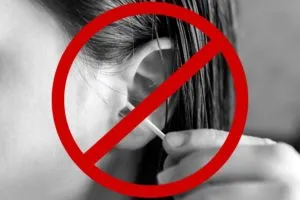
Tips for managing ear wax at home
Ear wax (otherwise known as cerumen) is a natural substance produced by the glands in your ear canal. It plays an essential role in keeping your ears clean and protected from dust and debris.
However, sometimes it can build up and cause discomfort, hearing loss and even infections. Understanding how to manage ear wax at home can help maintain healthy ears while avoiding unnecessary complications.
Understanding ear wax and its purpose
Before diving into tips for ear wax removal, it’s important to understand its function. Ear wax traps dust and other small particles, preventing them from reaching the delicate inner parts of your ear.
Did you know it also has antibacterial properties? This helps reduce the risk of ear infections. For most people, ear wax naturally works its way out of the ear canal as you chew, talk and move your jaw. However, some people may produce more ear wax than necessary or have a narrower ear canal, leading to blockages.
Signs of ear wax build-up
Excess ear wax doesn’t always cause symptoms, but when it does, you might notice:
- Reduced hearing or a feeling of fullness in the ear
- Itching or irritation in the ear canal
- Ringing in the ear (tinnitus)
- Dizziness or balance issues in severe cases
If you experience these symptoms, it’s worth considering safe methods to manage ear wax at home.
How to remove stubborn ear wax at home
There are some safe and effective methods you can use to remove ear wax at home. These include using over-the-counter ear drops to soften wax, applying warm olive or almond oil to help loosen it.
It’s important to avoid using cotton buds at all costs, as this can push ear wax further into the canal and cause blockages. By following these methods, you can manage minor wax build-ups effectively while keeping your ears healthy.
1. Use over-the-counter ear drops
Pharmacies and health and beauty retailers in Hampstead stock ear drops specifically designed to soften ear wax. Products containing hydrogen peroxide, glycerine or saline can help loosen stubborn wax, making it easier for your body to expel naturally. Be sure to follow the instructions on the packaging and avoid overusing these products.
2. Warm olive oil or almond oil
A few drops of warm (not hot) olive or almond oil can be an effective way to soften ear wax. Use a clean dropper to apply the oil, tilt your head to the side and allow it to sit for a few minutes before tilting your head back to let it drain. Repeat this process twice a day for several days.
Please remember: Avoid using cotton buds to clean the ear
It’s tempting to use cotton buds to remove ear wax, but this often pushes the wax deeper into the ear canal, potentially causing blockages or damage to the eardrum. Instead, stick to external cleaning by wiping the outer ear with a damp cloth.
We also would not advise trying to clear your own wax using any tools bought online like ear picks or ear irrigators as these products tend to lead to more problems than solutions.
When to seek professional help
While managing ear wax at home can often resolve minor issues, there are times when professional intervention is necessary. You should see a healthcare provider if:
- Home remedies have not improved your symptoms;
- You experience severe pain, dizziness, or persistent hearing loss;
- You suspect you have an ear infection (signs include swelling, redness, and discharge);
- There is a history of perforated eardrum or ear surgery.
Finding professional ear wax removal services in Hampstead
If you’re in Hampstead, London, then you’re in luck! Hampstead Hearing is a private hearing clinic with highly trained audiologists and specialists equipped with tools and knowledge to perform services such as microsuction, irrigation or manual removal techniques. Microsuction, in particular, is a popular and safe method for removing stubborn ear wax under magnification.
FAQs about ear wax management
Is ear wax removal painful?
Professional ear wax removal methods, such as microsuction, are generally painless. You might feel slight discomfort during irrigation or manual removal, but these methods are safe when performed by a professional.
How often should I clean my ears?
Most people do not need to clean their ears regularly. The ear is self-cleaning, and excess ear wax often works its way out naturally. However, if you’re prone to wax build-up, consult an audiologist for guidance on maintenance.
Are ear candles effective?
Ear candling is not recommended as it is ineffective and poses risks such as burns or damage to the ear canal.
Quick tips for preventing ear wax build-up
While it’s impossible to stop ear wax production altogether (and you wouldn’t want to), there are steps you can take to reduce build-up:
- Avoid inserting objects like cotton buds into your ears
- Stay hydrated to maintain optimal ear canal health
- Consider using ear drops periodically if you are prone to excessive wax
- Protect your ears from excessive exposure to dust or debris
Hampstead Hearing: Your hearing health matters
Managing ear wax at home doesn’t have to be complicated. With the right approach, you can maintain healthy ears and address minor build-ups without difficulty.
However, it’s crucial to recognise when professional help is needed to avoid complications. For those in Hampstead and the wider London area, professional ear care services are readily available to help you maintain your ear health safely and effectively.
If you’ve been wondering how to remove stubborn ear wax at home or when to seek professional ear wax removal, these tips provide a great starting point. Prioritise your ear health and seek advice from our qualified professionals if needed to ensure your ears remain in top condition. You can find all of our contact information here.
Hampstead Hearing, part of the renowned Harley Street Hearing group, is a leading provider of independent, expert hearing and ear healthcare in the UK. We specialise in comprehensive hearing assessments, state-of-the-art hearing aids, tinnitus management, and a wide range of personalised services designed to support your hearing health.
Read More

How do hearing aids help manage tinnitus?
Tinnitus affects millions of people worldwide and is commonly described as a persistent ringing, buzzing, or humming sound in the ears. For some, tinnitus is merely a minor inconvenience, whereas for others the symptoms can significantly impact their quality of life.
While there is no definitive cure for tinnitus, various management techniques are available, with hearing aids recognised as an effective tool for managing the condition. We will explore how hearing aids help alleviate tinnitus, the mechanisms behind their success, and the signs that suggest you should consult an audiologist for tinnitus management.
What brings on tinnitus?
Although tinnitus is often referred to as a disease, it isn’t a disease at all. Tinnitus is a condition that occurs as a result of various conditions, including hearing loss, ear injuries, exposure to loud noises, or even stress and anxiety.
The noise associated with tinnitus is subjective, meaning only the affected individual can hear it. This sound can range from mild and intermittent to severe and constant, often interfering with concentration, sleep and a person’s overall well-being.
One of the most common causes of tinnitus is hearing loss. When hearing diminishes, the brain compensates by amplifying certain frequencies, which can inadvertently result in tinnitus. Therefore, addressing the root cause of hearing loss is key to managing tinnitus effectively, and this is where hearing aids come into play.
Can hearing aids help tinnitus?
If you’re wondering whether hearing aids can help manage your tinnitus, the answer is a resounding yes! Hearing aids are small electronic devices designed primarily to improve hearing. They amplify external sounds, making it easier for people with hearing loss to engage with their surroundings.
But how do hearing aids help with tinnitus? Each hearing aid is different and its features depend on the make, model and size. Here’s a breakdown of the mechanisms:
Amplifying background sounds
For individuals with hearing loss, the absence of sound can exacerbate their tinnitus. The brain can choose to focus on the lack of stimulation in the absence of external stimuli. Hearing aids amplify ambient sounds, such as conversation, nature sounds or background noise, which can mask the internal ringing or buzzing. This effect, known as sound masking, helps reduce the prominence of tinnitus.
Tinnitus-specific features
Many modern hearing aids come equipped with tinnitus management features. These features include built-in sound generators that produce soothing noises, such as white noise, pink noise or ocean waves. These sounds can be customised to the individual’s preferences, helping distract the brain from tinnitus and providing a sense of relief.
Restoring auditory input
Hearing loss reduces the amount of sound signals reaching the brain, which can cause neural pathways to misfire and produce tinnitus. By restoring auditory input through amplification, hearing aids can rebalance the auditory system. This process, known as auditory enrichment, helps the brain focus on meaningful sounds rather than tinnitus.
Enhancing communication
One of the frustrating aspects of tinnitus is its impact on communication. Struggling to hear amidst the noise in your head can be isolating. Hearing aids amplify speech, making conversations clearer and helping you stay engaged in social situations. This improved communication reduces feelings of isolation and improves mental well-being.
Choosing the right hearing aid for tinnitus
Not all hearing aids are equally effective in managing tinnitus, so selecting the right one is essential. Look for devices with built-in tinnitus masking options, such as sound therapy features that produce soothing sounds like white noise or nature sounds. The ability to customise your devices is another important factor, as being able to personalise settings ensures the device meets your specific requirements.
When should I see someone about my tinnitus?
While tinnitus is common and not always a cause for concern, certain signs suggest it’s time to consult an audiologist for advice. Persistent or worsening tinnitus lasting longer than a few weeks should be evaluated, as should any accompanying loss in hearing capacity. This may indicate underlying hearing loss that could be alleviated to reduce tinnitus symptoms.
Sleep disturbances caused by tinnitus can affect overall health, and sound therapy through hearing aids can help promote better rest. Emotional distress, such as frustration, anxiety, or depression linked to tinnitus, is another reason to seek help, as audiologists can provide support and resources.
Unilateral tinnitus, meaning it occurs in only one ear or alongside symptoms like dizziness, vertigo or hearing loss, may signal a more serious condition requiring prompt attention. Similarly, a sudden onset of tinnitus, especially after an injury or exposure to loud noise, needs immediate evaluation to prevent potential long-term damage.
What to expect at your audiology appointments at Hampstead
Visiting our audiologists for tinnitus management involves a thorough evaluation of your auditory health. The process typically begins with a discussion of your medical history, lifestyle and specific tinnitus symptoms.
The audiologist will ask questions about when the tinnitus started, its severity, and any factors that may contribute to or worsen the condition. These details are vital for accurate diagnosis and treatment planning.
A hearing test is carried out to determine whether hearing loss is a contributing factor. This involves listening to sounds of varying frequencies and volumes to assess your hearing range and pinpoint any deficiencies. We may use specialised tools to measure the pitch and volume of your tinnitus, which helps them develop a tailored treatment plan that addresses your unique needs.
Based on the results, Hampstead Hearing Clinic will provide treatment recommendations. This could include hearing aids with tinnitus-specific features, sound therapy, counselling or a combination of approaches.
Our goal is to reduce the impact of tinnitus and improve your overall quality of life.
How to live with tinnitus
While tinnitus can be challenging, it doesn’t have to control your life. Hearing aids offer a practical and effective way to manage symptoms, by improving hearing and quality of life. Combined with other strategies, such as sound therapy, relaxation techniques and lifestyle changes, they can help you regain a sense of normality.
If you’re experiencing tinnitus, don’t hesitate to seek help. Our audiologists can guide you through the process, offering solutions tailored to your unique needs. With the right tools and support, managing tinnitus is not just possible – it’s achievable! Book your appointment with Hampstead Hearing Clinic and get on the path to better hearing today.
Read More
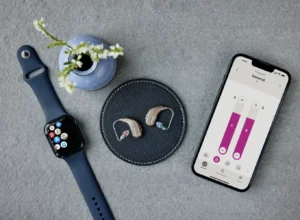
Oticon Intent: A Leap in Hearing Aid Technology
Oticon Intent: A Leap in Hearing Aid Technology
Have you ever pondered the role of artificial intelligence (AI) in hearing aids? You might be surprised to learn that some hearing aids are equipped with AI. Oticon, a leading name in the industry, has taken its technology a step further with the introduction of the Oticon Intent. This article will delve into the new features of the Oticon Intent, its availability, and its suitability for different types of hearing loss.
A Look Back at Oticon’s Evolution
Oticon has been consistently innovating in the field of hearing aids. Their last major release was the Oticon Own in September 2022, which included a variety of models like the IIC, CIC, ITC, and ITE. These were followed by the receiver in canal style of hearing aids in March 2023, which included the miniRITE R and miniRITE T, the Mini BTE R and Mini BTE T, and a CROS system design for those with single-sided deafness.
When the Oticon Reals were launched, they brought some advancements over their predecessor, the More family of hearing aids. However, the changes were minor, focusing on wind and noise handling and the introduction of a sudden sound stabiliser. Despite these improvements, the technology was largely similar to the Oticon More family.
The Oticon Intent Hearing Aid: Meeting User Expectations
Based on user feedback, the most sought-after features in a hearing aid are improved hearing in noise and enhanced speech clarity. Oticon’s latest innovation, the Oticon Intent, aligns perfectly with these needs.
This new design is a little shorter than their previous hearing aid technology which is ideal if discretion is important to you. It is also Oticon’s smallest ever Bluetooth receiver in canal hearing aid to date. It is however a fraction bulkier, so I do wonder how that will feel when it’s sat behind your ear, especially when competing for space for anybody wearing glasses out there.
Oticon Intent is available in nine colours to suit your skin, hair or personal preference, now introducing the new Sky Blue to the Oticon range. Oticon have also removed the rocker switch that they had on the Oticon Real and they’ve replaced it now with a single button on the back of the hearing aid.
Inside the Oticon Intent: A Technological Marvel
The Oticon Intent is powered by a new chip called Sirius, which brings three key features for improved speech clarity in the presence of background noise.
One of the standout features of the Oticon Intent is the new 4D sensor technology. By monitoring conversational activity, head and body movement, and the surrounding environment, these hearing aids can recognise when the user’s needs change and adapt the settings accordingly. This feature can improve speech comprehension by 15%.
Intent’s Connectivity and Rechargeability
Oticon has also revamped the connectivity of their hearing aids. They’ve introduced LE Audio, a feature that allows users to receive sound directly to their hearing aids in public venues like concert halls, conferences, and train stations. While this technology is still in its early stages, Oticon has ensured that the Intents still have a built-in telecoil, a feature that provides similar functionality.
In terms of rechargeability, Oticon has increased the size of their batteries. A single charge now only takes 2 hours, and a quick 15-minute charge can provide 4 hours of usage. However, if there’s an issue with the batteries, the whole hearing aid will need to be sent to Oticon for repair.
Oticon Intent Hearing Aid Review
Matthew Allsop serves as a Partner for the Harley Street Hearing group and contributes as a content creator for Hearing Tracker. Through his platform, he offers candid insights into the latest advancements in hearing aid technology. Hearing Tracker stands out as the premier impartial resource dedicated to aiding hearing aid consumers worldwide. See his review for Oticon Intent below.
If you’re interested in trialling this or any new technology please don’t hesitate to contact us.
Read More
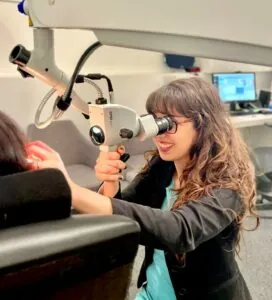
Unblocking Your Ears with Specialist Audiologist Techniques
Why Do Our Ears Block With Wax?
Our ability to hear is fundamental to how we experience the world around us. However, there are times when our ears may feel blocked, leading to discomfort and even temporary hearing impairment. Whether it’s due to wax build up, fluid accumulation, or other factors, addressing ear blockages promptly is crucial for maintaining optimal hearing health.
In this guide, we’ll explore how specialist audiologists tackle ear blockages and provide insights into techniques they employ to help you unblock your ears effectively.
The most common causes include:
Earwax Build-up: The ear naturally produces wax to protect the ear canal. However, excessive wax accumulation can lead to blockages.
Fluid Accumulation: Fluid build-up behind the eardrum, often due to infections or allergies, can cause a feeling of fullness and temporary hearing loss.
Foreign Objects: Small objects or insects may inadvertently enter the ear canal, causing blockages and discomfort.
Barotrauma: Sudden changes in air pressure, such as during air travel or scuba diving, can lead to ear barotrauma, resulting in ear blockages and pain.
Who does Ear Wax Removal?
Your ears are very delicate organs so it’s essential that you seek advice from a highly qualified hearing healthcare provider, or audiologist if you’re experiencing an ear blockage.
Good Practice From Your Audiologist
Maintaining good ear hygiene and seeking prompt treatment for ear-related issues are key to preserving your precious sense of hearing for years to come. So let’s see how a qualified audiologist can assist safely with your ear wax removal.
How To Remove Ear Wax Safely
Microsuction
- Microsuction is a precise and minimally invasive procedure used to remove earwax and debris from the ear canal. This is the preferred method of ear wax removal.
- Audiologists use a suction device with a thin bent tube to gently extract the blockage under direct vision using a microscope.
- This method is highly effective, pain-free and suitable for individuals with sensitive ears or a history of ear infections.
Ear Irrigation
- Ear irrigation involves flushing the ear canal with a gentle stream of water to remove excess wax build-up.
- Audiologists use specialised equipment to ensure safe and effective removal of earwax without causing damage to the ear canal or eardrum.
- This technique is particularly useful for individuals with stubborn or impacted earwax.
- This method is not advised if you have an ear infection or history of ear infections.
Ear Syringing
- Once a traditional approach to wax removal, ear syringing is now deemed outdated and potentially unsafe.
- The modern substitute is electronic irrigation.
Ear Examination and Assessment
- Before proceeding with any treatment, audiologists conduct a thorough examination of the ears to identify the cause of the blockage.
- This may involve otoscopy, where a specialised instrument called an otoscope is used to visualise the ear canal and eardrum.
- By accurately diagnosing the underlying issue, audiologists can tailor their approach to each individual’s needs, ensuring the most appropriate treatment.
Education and Prevention
- In addition to providing treatment, audiologists offer valuable education on ear care and prevention strategies.
- This may include guidance on how to safely clean the ears at home, using techniques such as olive oil or over the counter ear drops.
- Audiologists also educate patients on the importance of protecting their ears from loud noises using custom hearing protection and avoiding the use of cotton ear buds or other objects that can push wax deeper into the ear canal.
Ear Wax Removal Near Me
Hampstead Hearing provide same-day ear wax removal appointments at clinics throughout London. We are part of the Harley Street Hearing group, so if you’re in Swiss Cottage, Belsize Park, Golders Green or Harley Street we’ll be delighted to see you.
Our microsuction procedures are conducted by highly skilled clinical audiologists who use high-spec examination microscopes with x20 magnification, which ensure they can work safely in the ear canal with complete visibility and depth perception.
Contact Us so we can have you hearing clearly again in no time.
Read More
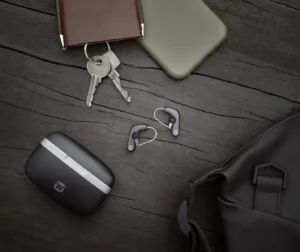
Introducing the Widex SmartRIC
Widex’s SmartRIC
One of the leading hearing aid manufacturers Widex, is unveiling a revolutionary new addition to their lineup: the SmartRIC hearing aid. This latest innovation promises not only a fresh design but also enhanced functionality, setting a new standard in the industry.
Unparalleled Sound Quality
One of the hallmarks of Widex hearing aids is their exceptional sound quality. Audiologists often find that once a patient experiences the natural sound produced by Widex, they are reluctant to switch to any other brand. This loyalty is attributed to Widex’s unique sound philosophy, which emphasises that less is more when it comes to achieving natural sound reproduction.
Sleek L-Shaped Design
The most striking feature of the SmartRIC Hearing Aid is its slim, L-shaped design. This innovative design incorporates directional microphone inlets that discreetly tuck the microphones away on the sides. Widex asserts that this new microphone position, angled at approximately 20 degrees, offers two significant advantages over previous models:
Firstly, the adjusted microphone angle enhances the effectiveness of directional microphones, resulting in improved performance in challenging listening environments, such as noisy backgrounds.
Secondly, by positioning the microphones more inconspicuously, the SmartRIC Hearing Aid demonstrates improved functionality in windy conditions and reduced handling noise. This means that wearers can expect a 20-decibel reduction in wind noise and an impressive 88% reduction in touch noise, making outdoor activities more enjoyable.
Vibrant Colour Options
Widex offers the SmartRIC Hearing Aid in five different colours, including four popular shades from their previous range and the addition of a stylish rose gold option. This allows wearers to choose a colour that suits their personal style and preference.
Enhanced Rechargeability with Smart Charger
In addition to redesigning the hearing aids themselves, Widex has revamped its rechargeability technology with the introduction of the SmartRIC charger. This innovative charger features a sleek, modern design with a magnetic shutter for secure closure, eliminating the need for fragile catches.
The SmartRIC charger utilises USBC charging and is also compatible with Qi Wireless technology for added convenience. With three LED indicators displaying battery life, this portable charger boasts an impressive capacity, storing up to five days’ worth of charge. This means wearers can enjoy extended battery life, with up to 37 hours of usage without Bluetooth streaming and up to 27 hours with eight hours of streaming.
Versatile Suitability and Exceptional Performance
Like other Widex hearing aids, the SmartRIC model features interchangeable receivers, making it suitable for a wide range of hearing losses, from mild to profound. Powered by the Widex Moment platform, these hearing aids deliver the most natural sound experience yet, complemented by Widex’s signature Pure Sound technology and tinnitus features, along with Bluetooth connectivity.
Recognised Excellence
In a recent report by Which?, Widex was rated as one of the top hearing aid brands by users, further validating the company’s commitment to innovation and quality.
Experience the Future of Hearing Technology
With its cutting-edge design, superior sound quality, and advanced features, the SmartRIC Hearing Aid by Widex is poised to redefine the standards of hearing technology. Discover the difference for yourself and elevate your hearing experience with Widex. To trial this new technology don’t hesitate to contact us.
Widex SmartRIC Hearing Aid Review
Matthew Allsop serves as a Partner for the Harley Street Hearing group and contributes as a content creator for Hearing Tracker. Through his platform, he offers candid insights into the latest advancements in hearing aid technology. Hearing Tracker stands out as the premier impartial resource dedicated to aiding hearing aid consumers worldwide. See his review for Widex SmartRIC below.
If you’re interested in trialling this or any new technology please don’t hesitate to contact us.
Read More

So You’re Thinking About Hearing Aids?
Exploring Hearing Aids: A Personal Journey
So, you’ve made the decision to explore hearing aids. This isn’t always an easy step, whether it’s something you’ve noticed yourself or it’s been suggested by someone else. We commend you for seeking out information, as hearing aids have the potential to significantly improve your quality of life.
Every Hearing Loss Story is Unique
Nearly every individual we see in our clinics has a unique journey that led them to consider hearing aids. It might be struggling to hear conversations in noisy environments, a loved one urging you to get your hearing checked, or difficulties communicating at work. Each person has their own story.
Personalised Care at Hampstead Hearing
Your experience with hearing loss is entirely your own. Recognising everyone’s unique journey, we at Harmpstead Hearing emphasise a personalised approach to hearing healthcare. We aim to share insights that we’ve found valuable as audiologists when discussing hearing aids with our patients, as well as what you can anticipate during a hearing aid assessment.
So You’re Coping?
One common sentiment we hear is the belief that one can “cope fine” without hearing aids. However, it’s akin to watching a football match on a black and white television. You can see the players moving, but it’s difficult to know who is on which team and which players you’re supposed to be cheering for.
Now, you switch over to your LED colour display television, the players come to life and your brain no longer needs to strain to identify which players are on which team—you can make out the players. Hearing aids can transform your auditory experience, reducing mental fatigue and enhancing engagement with the world.
Empowering Choices: Understanding Your Options
Now, let’s talk options. When you think of hearing aids, you might envision bulky devices of the past. However, today’s hearing aids offer a sleek, diverse array of styles and functionalities to suit your preferences and needs.
- Style: Options range from discreet behind-the-ear models to custom-made or completely invisible devices, available in various colours to match your appearance or preferences. During your assessment, your audiologist will discuss which style aligns best with your medical history, hearing test results, and lifestyle.
- Connectivity: Many modern devices can connect to your phone, enabling direct streaming of music, calls, and podcasts, tailored to your hearing needs.
- Apps: Most hearing aids come with accompanying apps, allowing you to adjust settings like microphone sensitivity, program preferences, and noise reduction, putting you in control of your listening experience.
Embracing the Journey
It’s essential to recognise that adjusting to hearing aids is a journey, not an instant fix like glasses. Your brain needs time to acclimatise to the new auditory input.
At Hampstead Hearing, we provide ongoing support from your initial fitting appointment to your crucial follow-ups, where your feedback shapes the fine-tuning of your devices to ensure optimal performance in your day-to-day life. And it doesn’t stop there, we will see you for as many appointments as it takes for you to be happy with your new hearing technology. From then on we will see you for a complimentary annual review as all of our hearing aid patients receive aftercare for life.
Take the Leap
Why not take the leap and reach out to us to explore the benefits of modern hearing technology? After all, nothing ventured, nothing gained!
If you’re interested in seeing how Hampstead Hearing can help you with any hearing issues please contact us.
Read More

